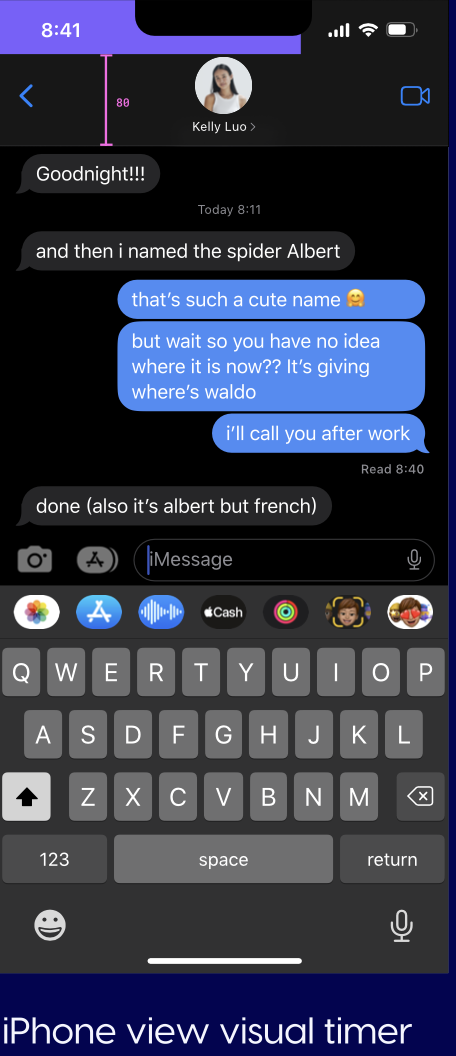About
Drawbridge supports your focus by eliminating external distractions and delaying internal distractions.
We designed Drawbridge for people with ADHD, who have an especially fragile process for building focus for work. While we cannot control what distracts us, Drawbridge aims to change how we respond to those distractions.
We wanted to focus on Knowledge Workers that have ADHD, as the self-directed nature of knowledge work conflicts with the strongest presenting symptoms of ADHD..
Background
What is ADHD?
ADHD, or Attention Deficit Hyperactive Disorder:
- difficulty sustaining attention
- disorganization
- forgetfulness
- easy distractibility.
On average, studies suggest that college graduates with attention deficit disorder earn $4,300 less per year than their peers who don’t have ADHD [2].
What is Knowledge Work?
Work that is:
- self-directed
- driven by information
- non-routine and non-linear problem solving
- requires a level of of formal, specialized training
Research
Research Questions
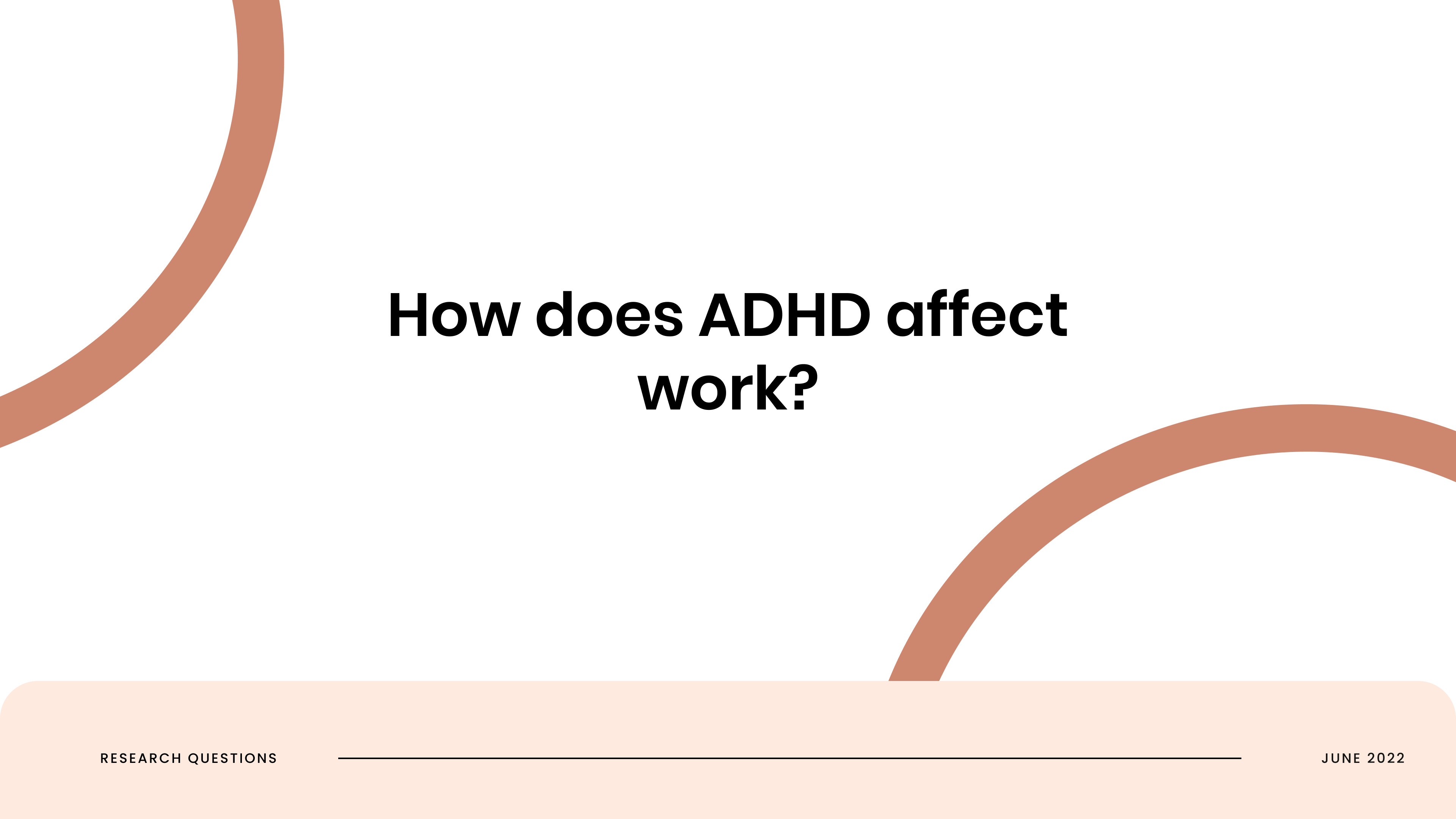
1
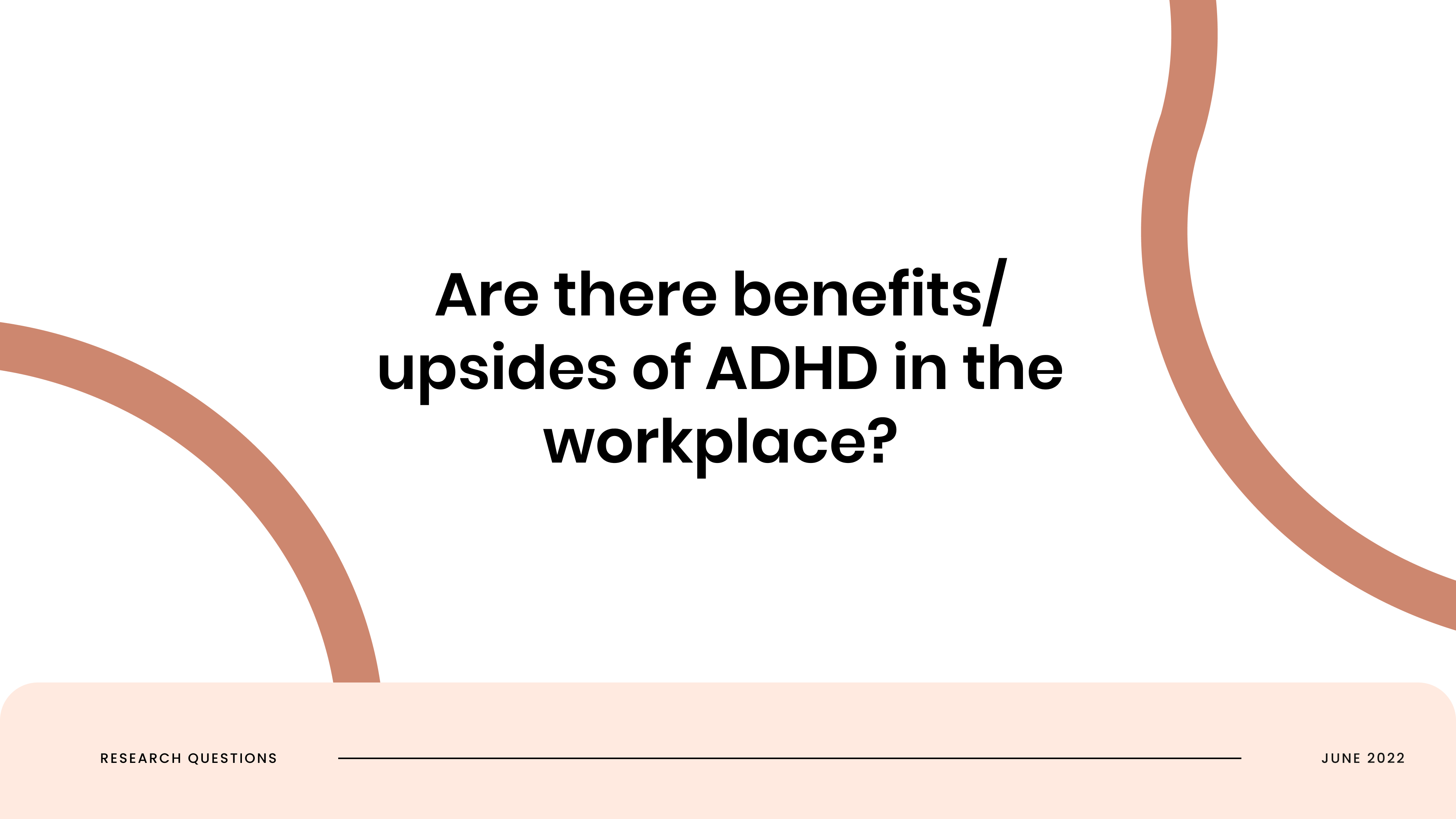
2
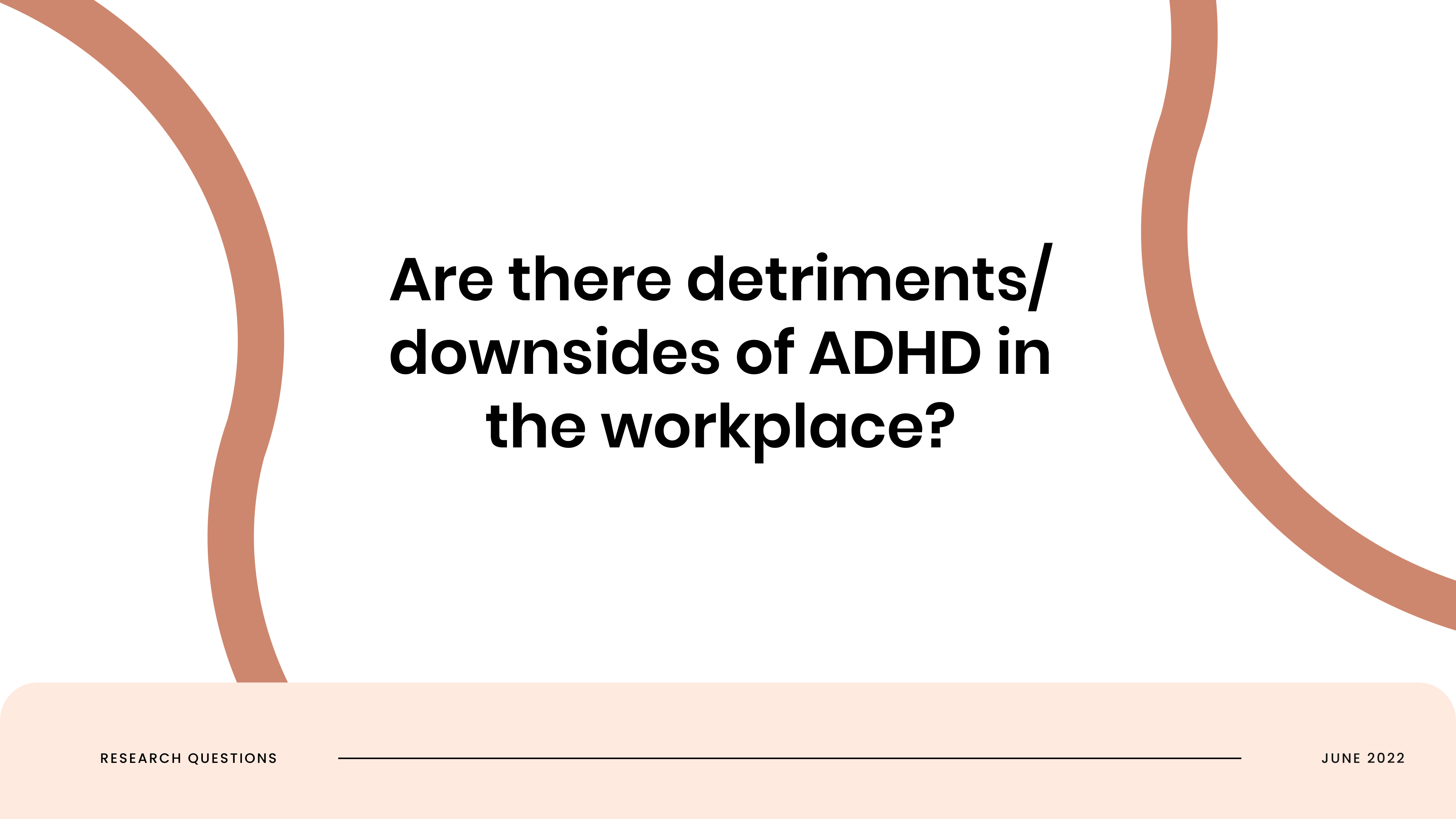
3

4
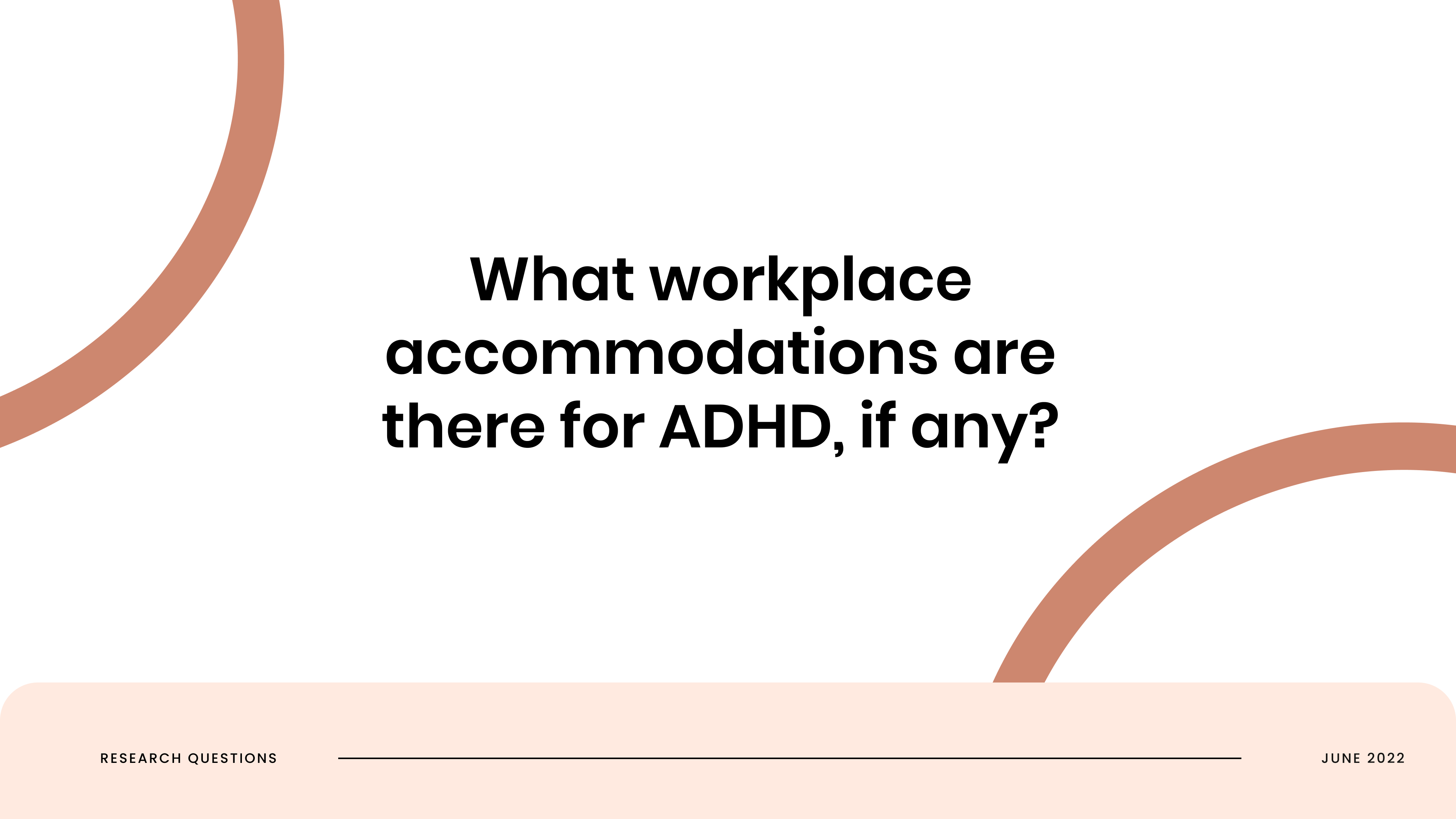
5
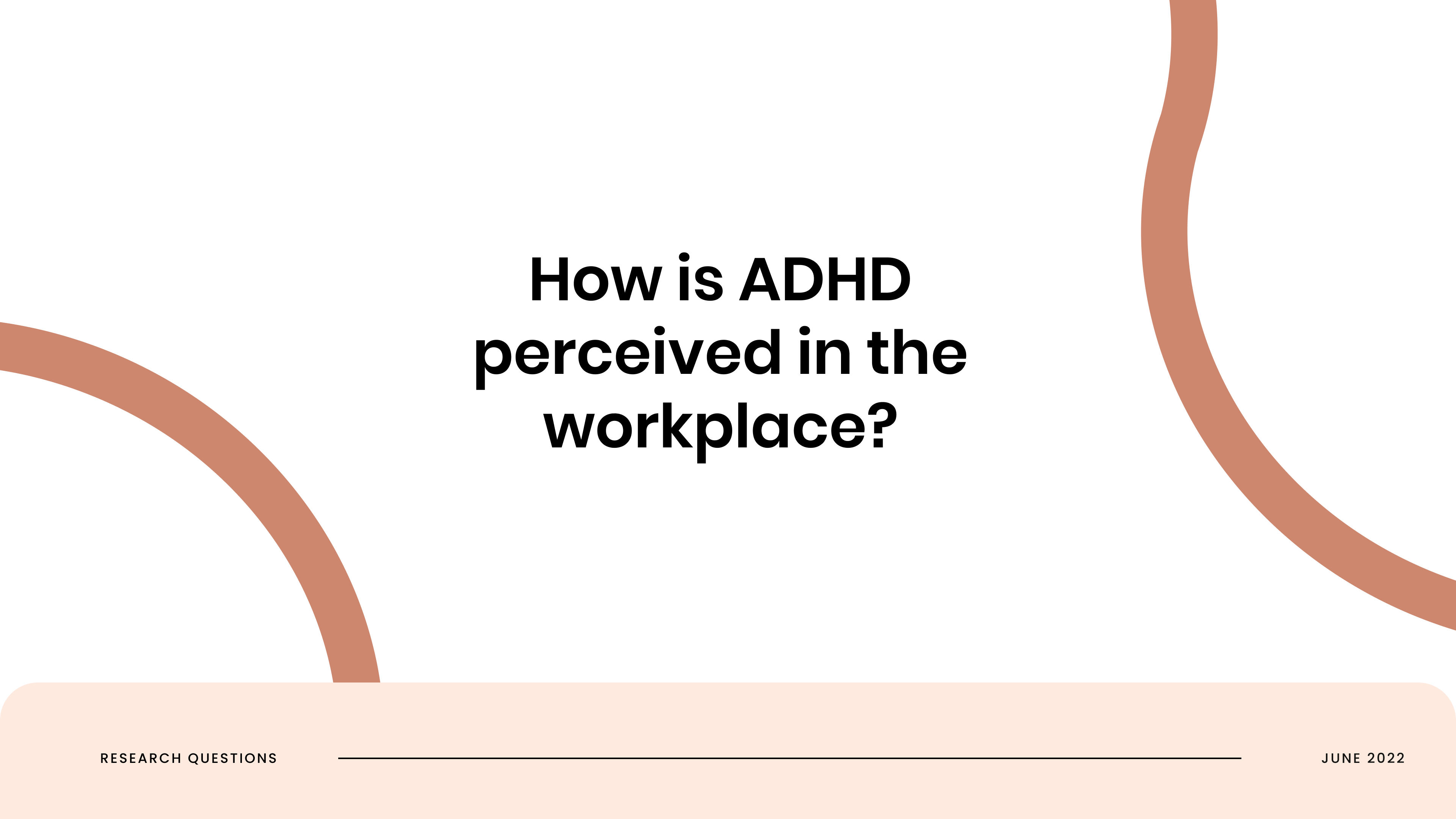
6
Methodology
N = 9 participants
Participant criteria:
- Diagnosed with ADHD
- Have held a knowledge worker job before
Participant demographics:
- Working professionals diagnosed with ADHD
- Equal gender spread
N = 5 Subject Matter Experts (SME)
SME criteria:
- Have deep experience with ADHD in a medical or professional capacity
Format
- Virtual Zoom interviews
- 1 person moderating, 1 person notetaking
- Recording of the session either via voice recording or Zoom
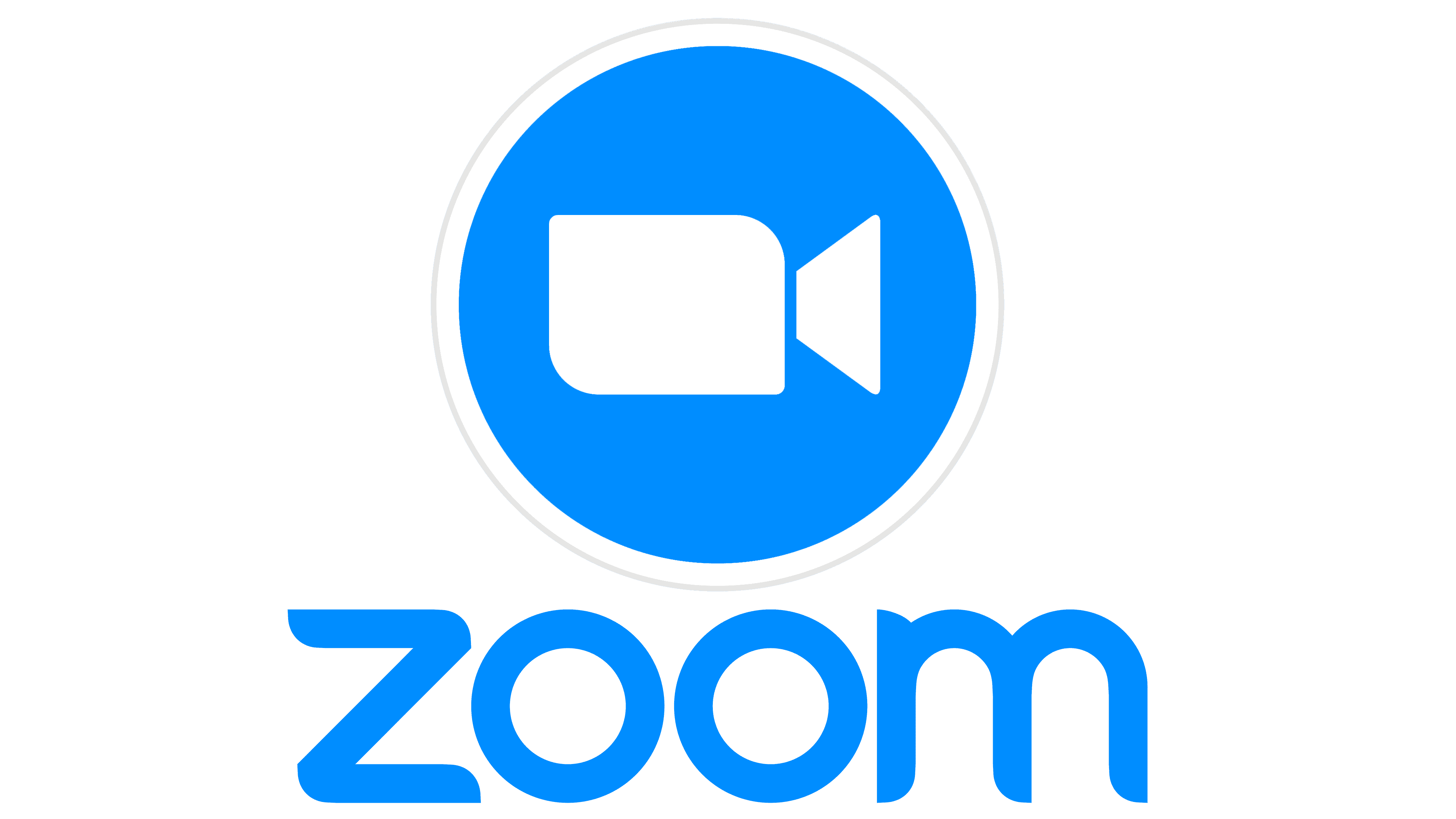
- We took notes on FigJam sticky notes during each interview.
- After each participant interview we wrote up a one-page summary of the interview highlights, important quotes, and key takeaways.
- After we finished all of our interviews, we coded and analyzed.
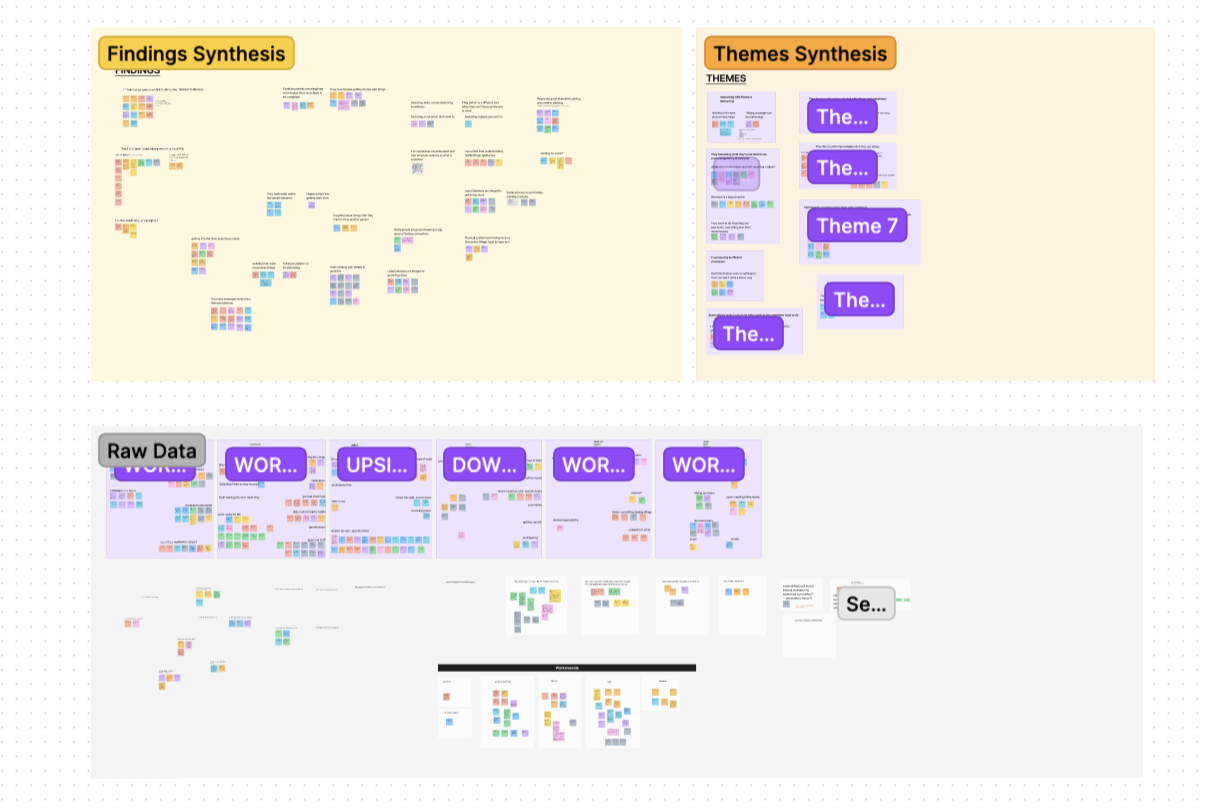
Research Plan
Subject Matter Expert Interviews

Key Takeaways
What we learned from talking with SMEs across industries, who were, worked with, and/or studied people that have ADHD(ADDers).
- ADDers have an interest-based nervous system.
- ADDers need to develop their own “owner’s manual” to manage their ADHD.
- There is no one size fits all solution for managing ADHD.
- ADDers need to learn to be “competent and successful in two totally different cultures.” The main culture of workplaces is designed for neurotypical people.
- Externalization of time and tasks can help keep ADDers on track, such as lists, planners, calendars, reminders, and visual timers.
- Minimize task changes. Changing tasks requires cognitive load each time.
- External accountability can help with remembering tasks and emotional regulation.
- ADHD comes with both upsides and downsides. Cannot have one without the other.
- Different ADDers have different playbooks for how to manage their ADHD.
- ADDers often fall into “failure spirals” that result from early friction with systems built for neurotypicals and do not reward their different thinking.
Results
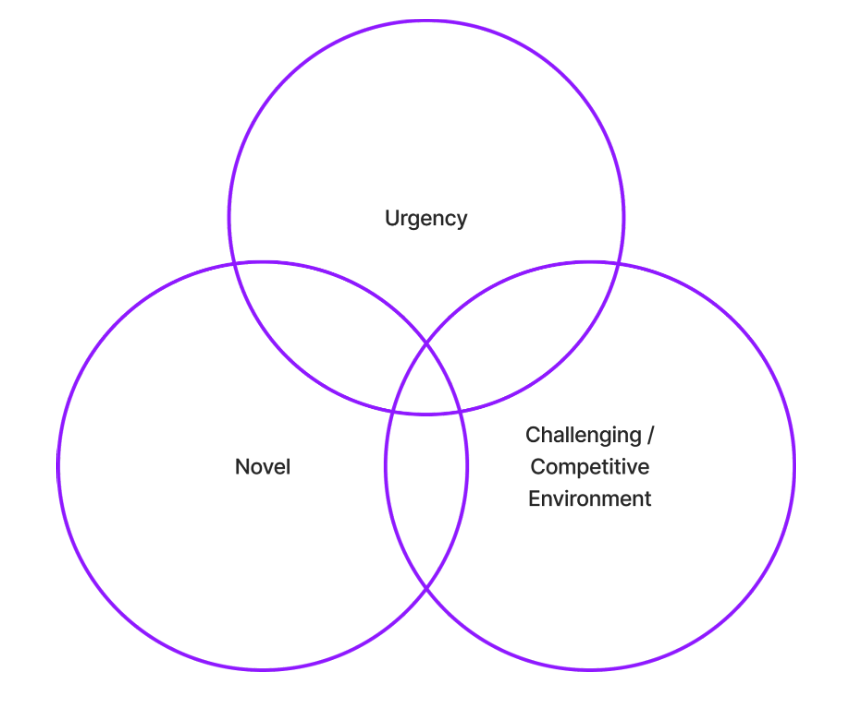
Based on our primary and secondary research, we realized that people with ADHD have a different nervous system than neurotypicals. ADDers don’t rely on an importance-based nervous system, but an interest-based nervous system to navigate the world.
Since interest is subjective, and certain tasks might be extremely uninteresting — they might find themselves in situations where these uninteresting tasks are thus inherently very hard, and sometimes impossible, to perform. In order to overcome these challenges and get the work done, ADDers need to inject interest into tasks.
Having one or more of the three things that drive an interest-based nervous system – such as novelty, urgency, and a challenging, competitive environment – helps them find something interesting and effectively easier to do
Interest-Based Nervous Systems
The Focus Staircase: The process to get work done
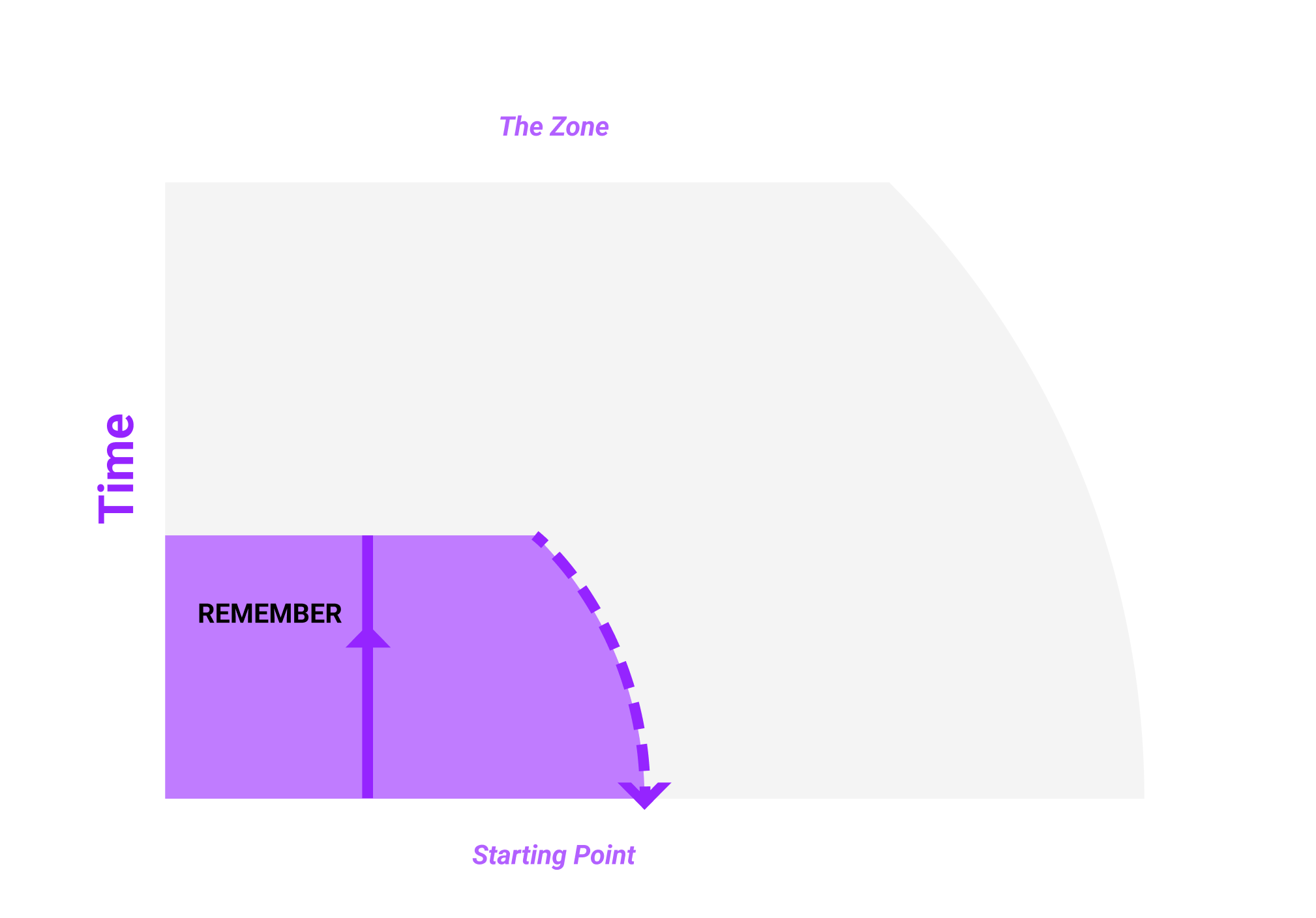
Step 1 involves remembering that something needs to be done. It is often hard for ADDers to stay on top of everything that they need to get to do. Failing to remember tasks often leads to unfinished or forgotten work.
1. Remember
Step 2 “Isolate” addresses the conditions ADDers need to get themselves to focus when they feel the need to. There might be agitators and distractions in their environment in terms of the physical like sounds, objects or sensations, as well as in terms of the digital like notifications, meetings etc. ADDers can combat this by having a set of workarounds, almost like a methodology, upon which they rely to get themselves to be able to focus. Each ADDer has a personal repertoire of strategies for focus.
2. Isolate

Step 3 “Focus” is the place where the ADDer feels completely engaged with the work they’re doing at the moment. They’ve gotten themselves to be engaged with their work, are completely focused on it and are getting it done.
They also feel fulfilled and are happy to be able to please their team or coworkers. It takes a lot to get to this point in the process, so if something gets them out of this, it is especially frustrating to them.
3. Focus
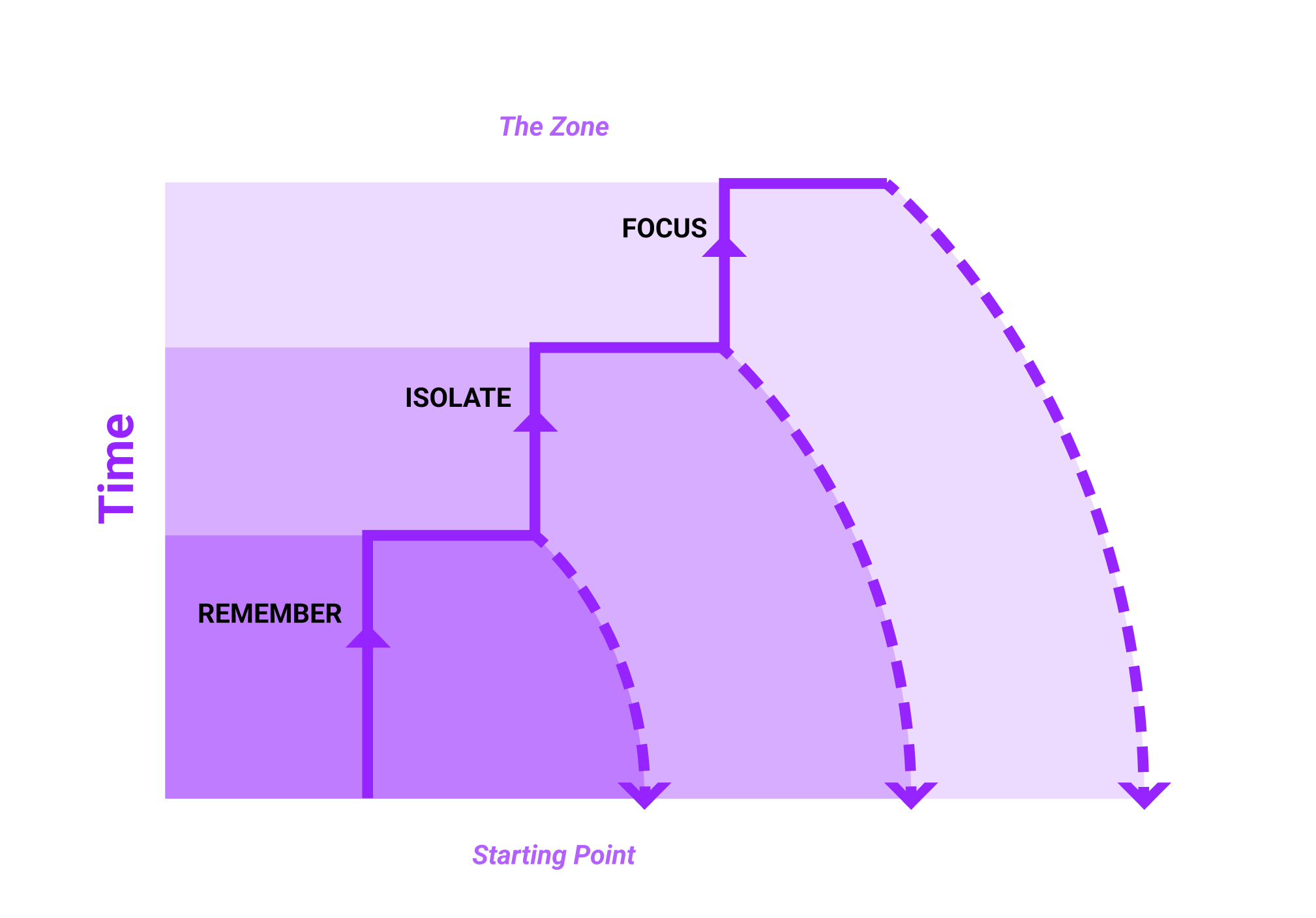
FOCUS
ISOLATE
REMEMBER
Starting Point
The Zone
Time
Insights
Finding: While doing solo work, participants find being around people, or background noises extremely distracting.
- ADDers need their own personal isolation bubbles, otherwise it’s impossible to get solo work done.
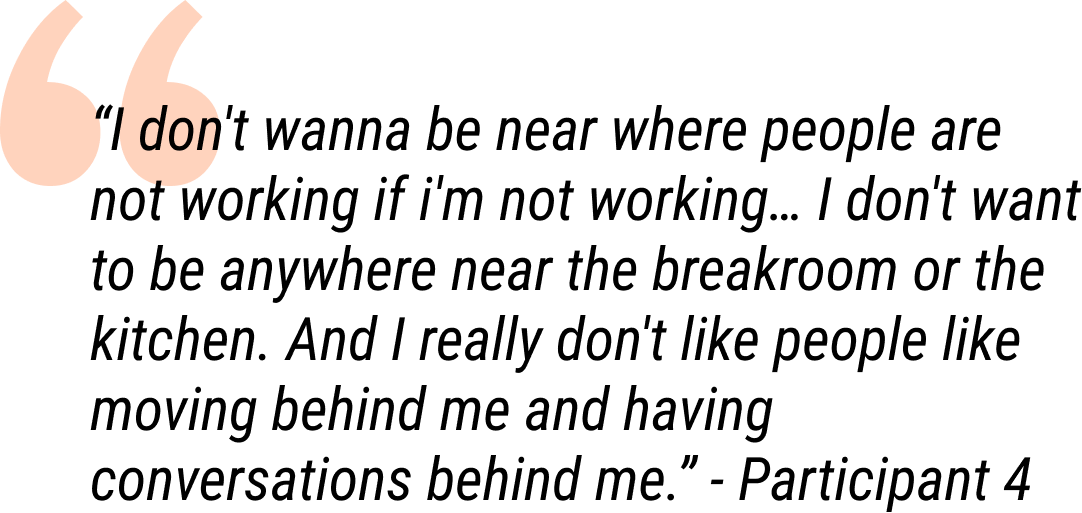
Finding: Participants have clearly defined times in their day when they are open to talking to people.
- “Not now, Toby!” For ADDers undisturbed solo work time is not a want, it’s a need.
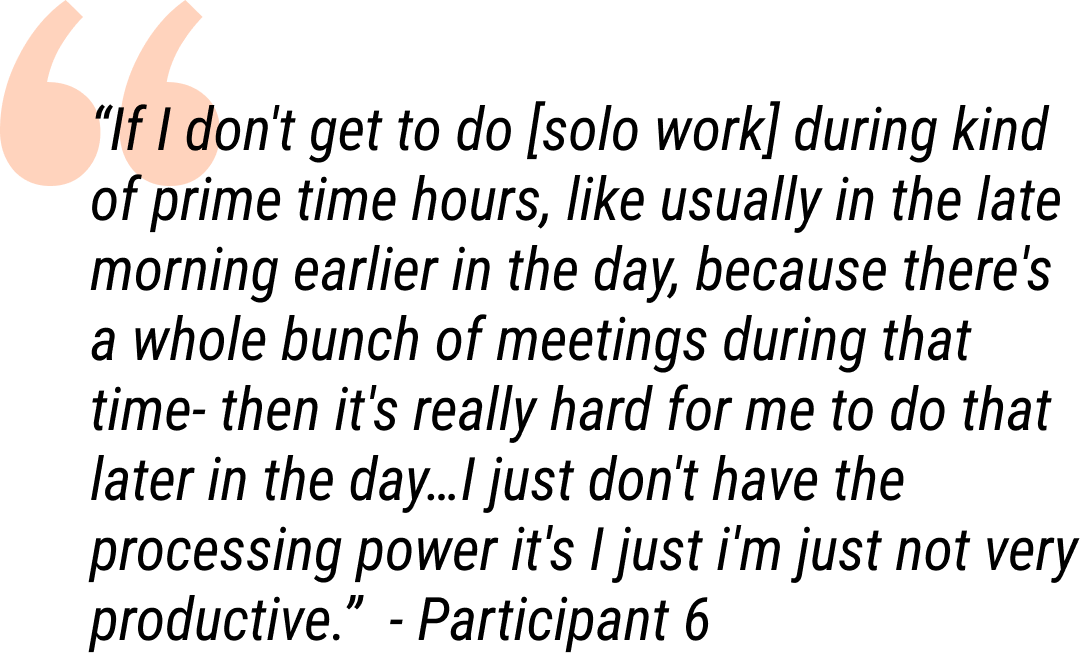
Finding: Participants have specific workarounds which work for them in order to focus.
- Methodology saves the day. Workarounds are the difference between frustration and productivity.

- Getting into focus is like building a house of cards. Once built, it must be protected.
Finding: Since being able to focus sometimes takes so much effort, falling out of it due to external factors feels very distressing.
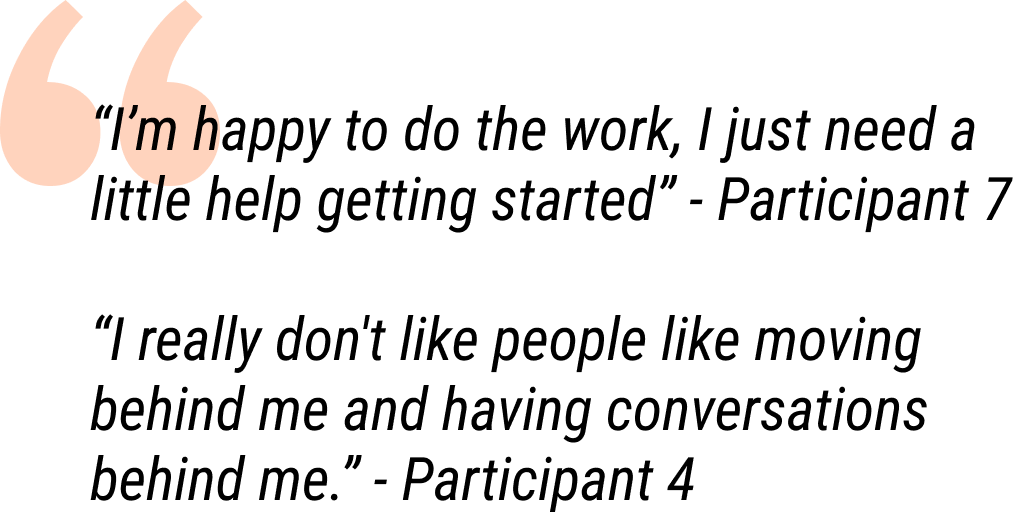
Finding: They are naturally good in situations which are urgent, rapidly changing, and dynamic.
- ADDers are like firefighters. When the stakes are high, their response matches the speed and urgency of the situation.
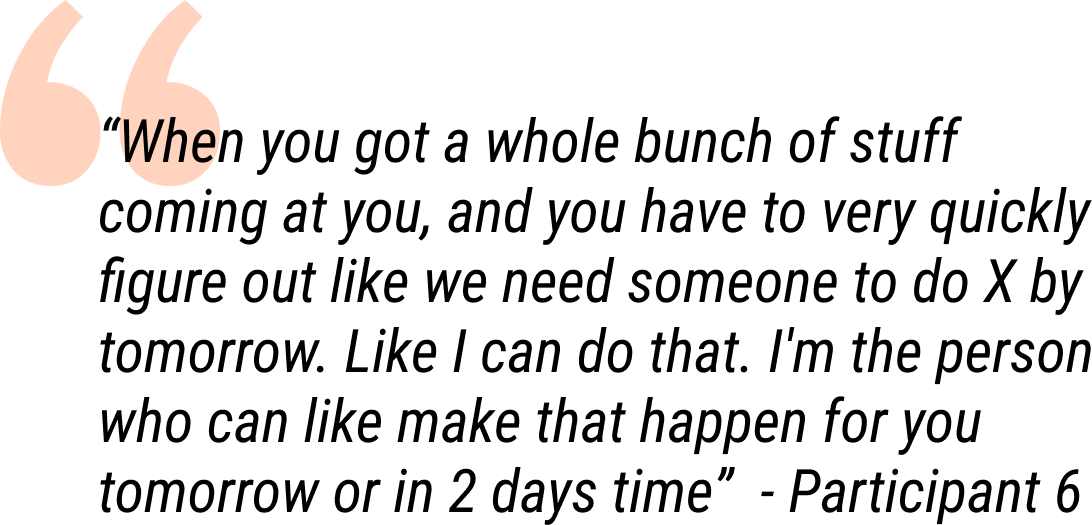

Design Principles
Design for ADDers that haven’t disclosed
Most of our participants do not currently disclose and do not plan to share that they have ADHD with their work colleagues. We would like to respect this preference, so our solution aims to be of service to an individual who would like to improve their workflow privately.
Our participant and SME interviews revealed that ADDers learn their own personal work styles, environmental preferences, and time management techniques. We would like to augment the processes ADDers already have in place by designing our solution to be flexible and customizable to whatever degree the user would like.
Be flexible and customizable
Complement their current workflow
We would like our solution to integrate with an ADDer’s existing work techniques, workflow, and tools they currently use. Ideally, our solution will not be an additional cognitive load or task in their everyday work.
Our participants expressed frustration with high levels of interrupting from their workflow by things like emails, notifications, and passerby in their work space. Our solution intends to provide help when it is needed, without contributing to even more sources of distraction.
Be inconspicuous when not needed
Respect their bubble
One of our insights expresses the need for ADDers to have undisturbed work time and a need for isolation during that time. We would like our solution to respect this “bubble” of solo work that each ADDer identifies, builds, and uses to get their work done.
Design
Early Design Process
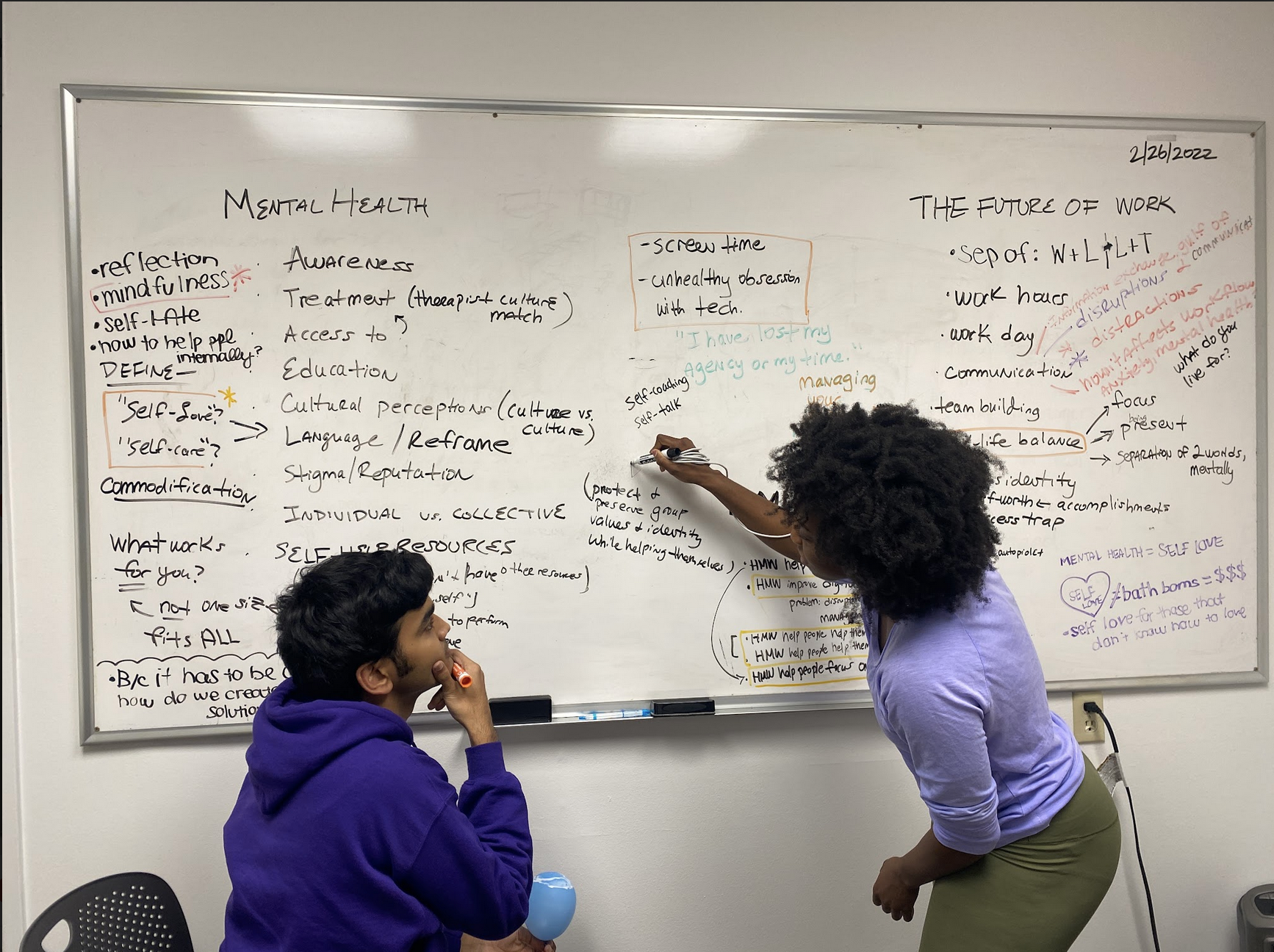
Downselection was guided by analogy by practical workplace restraints,
What tool could most easily adopted by an individual worker? What tool would do the most for a single person who works by someone else’s calendar? What sort of tool can we design that is customizable for any user? What product could be accessible both in cost and implementation? and our faithfulness to the individual user’s needs.
Our participants’ most pressing issues were distraction from notifications, from other people, and from advocacy for their needs.
We wanted to be careful about what we designed because the “standard” interactions that many desktop apps use now (push notifications, sounds, movement and color) were distracting to our users. We needed to ensure our product did not exacerbate this issue- we stayed true to our design principles and our research.
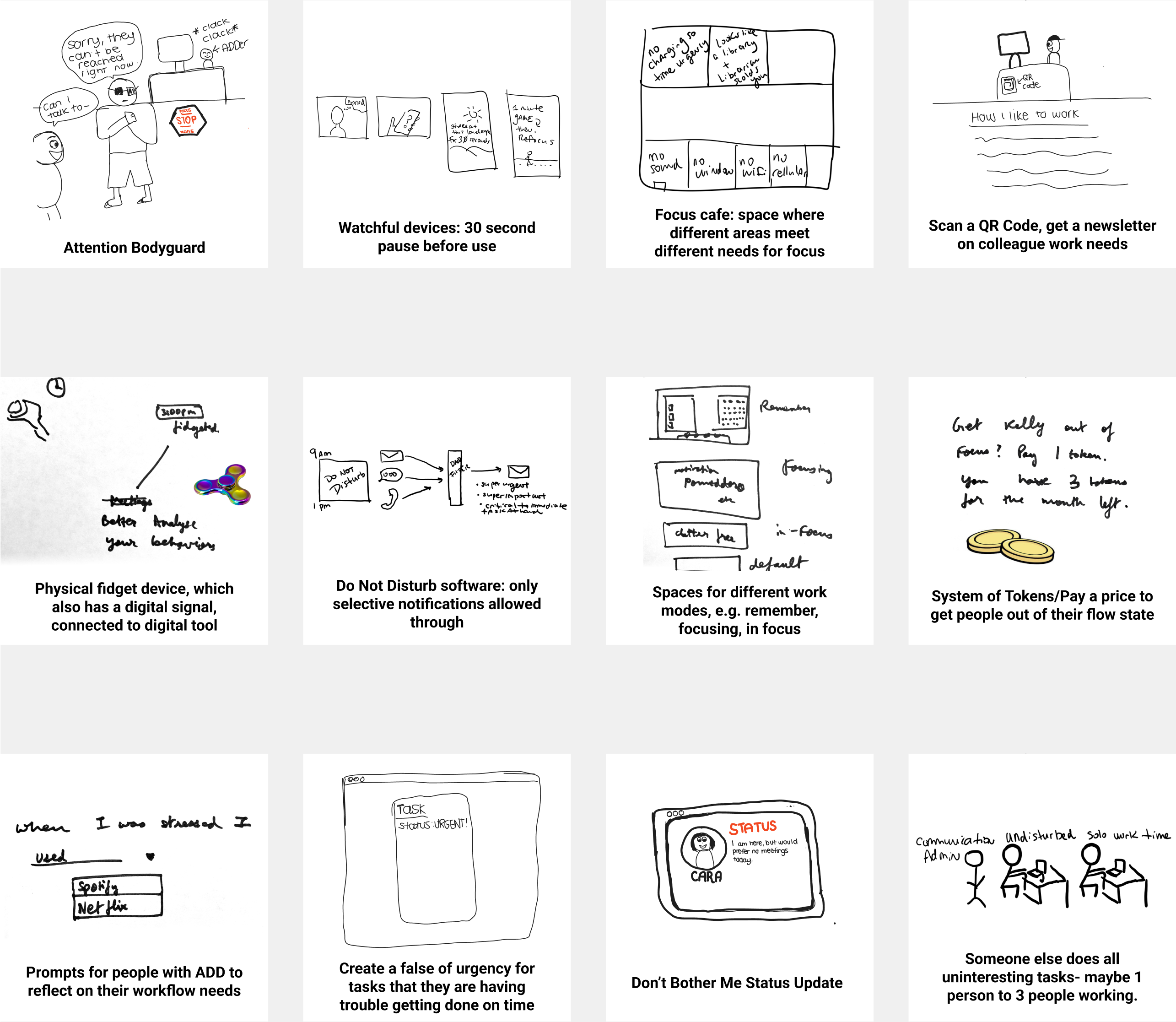

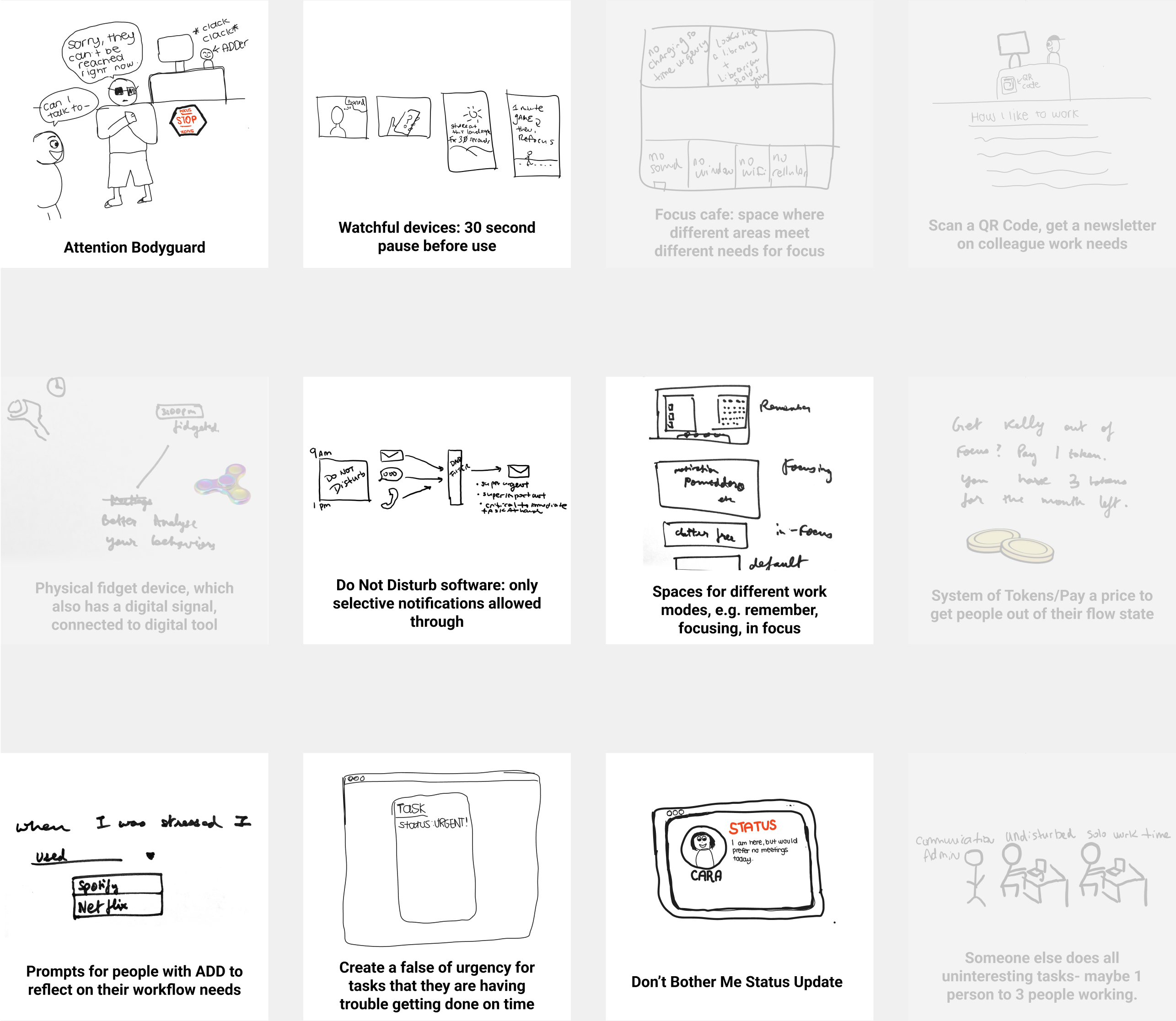
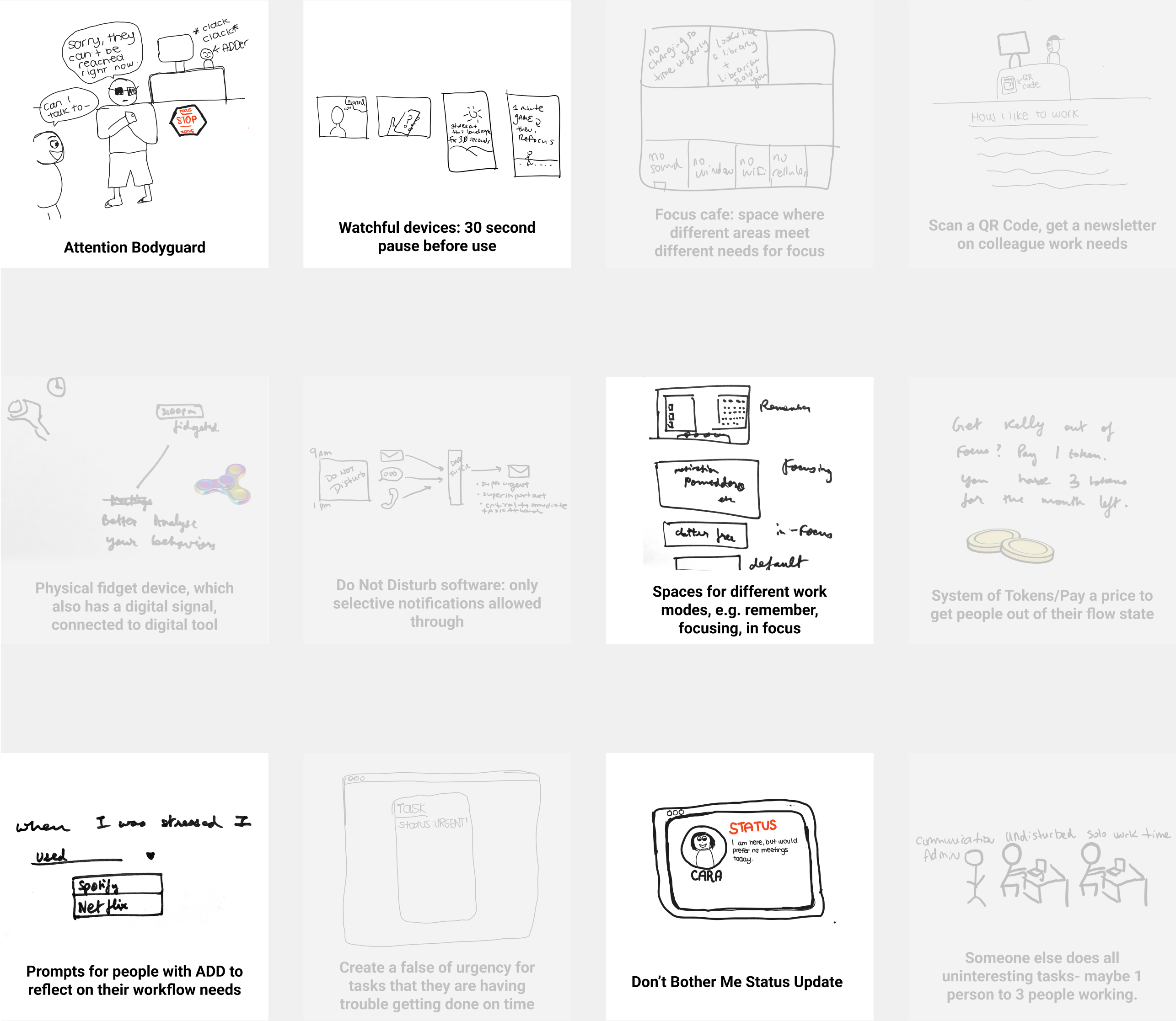
Set your FocusMode intention Drawbridge encourages you to set an intention before you enter FocusMode. Throughout your work session, Drawbridge reminds you of your goal in moments of distraction, encouraging you to stay on task and meet your target.
Write a ThoughtPopWhen a thought pops into your head while you work, Drawbridge allows you to use the MacOS “Spotlight” feature to quickly type out a thought and save it for later. Drawbridge categorizes your “ThoughtPops” into tasks or just thoughts. By collecting your impulses while you work, Drawbridge keeps and remembers for you while you stay focused.
Let’s Catch You UpWhen you finish your work, Drawbridge delivers all notifications and ThoughtPops in a consolidated screen called “Let’s Catch You Up.” You can also see changes to your calendars and different work groups. This summary view is customizable by application, person, or any combination of the two.
Interaction Flow
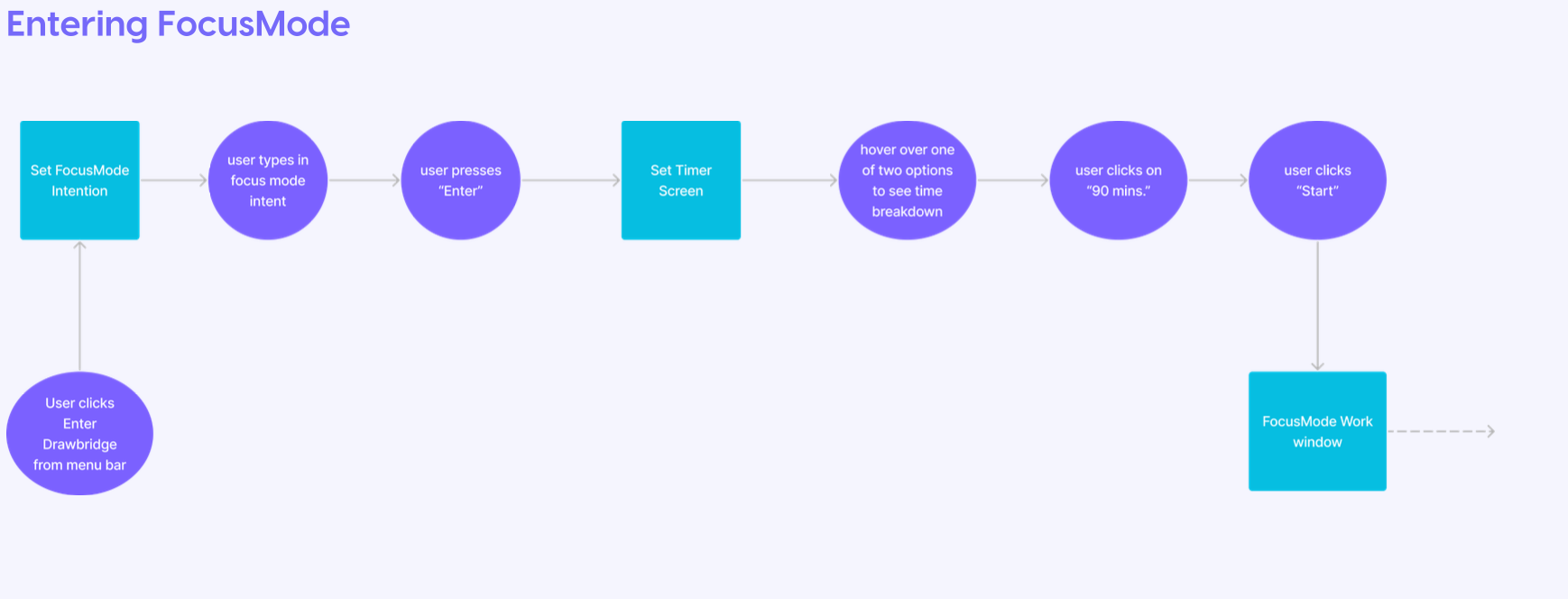
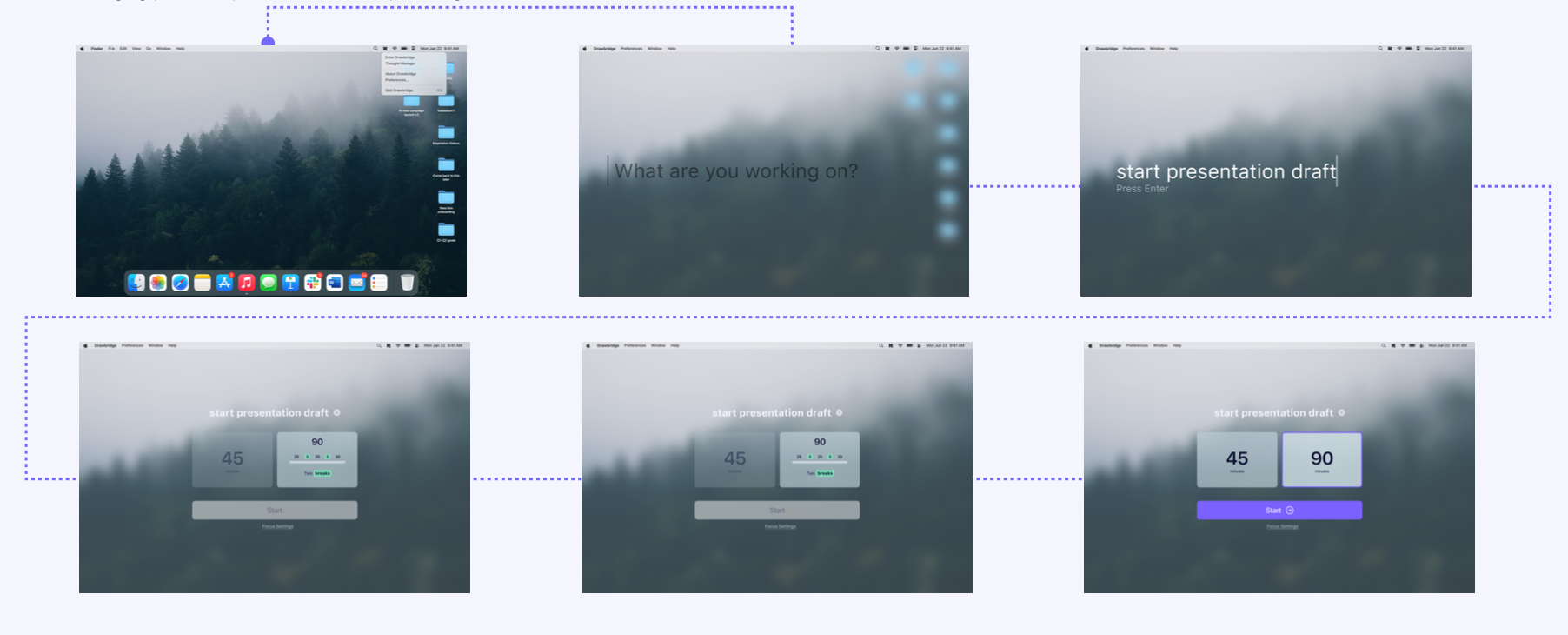
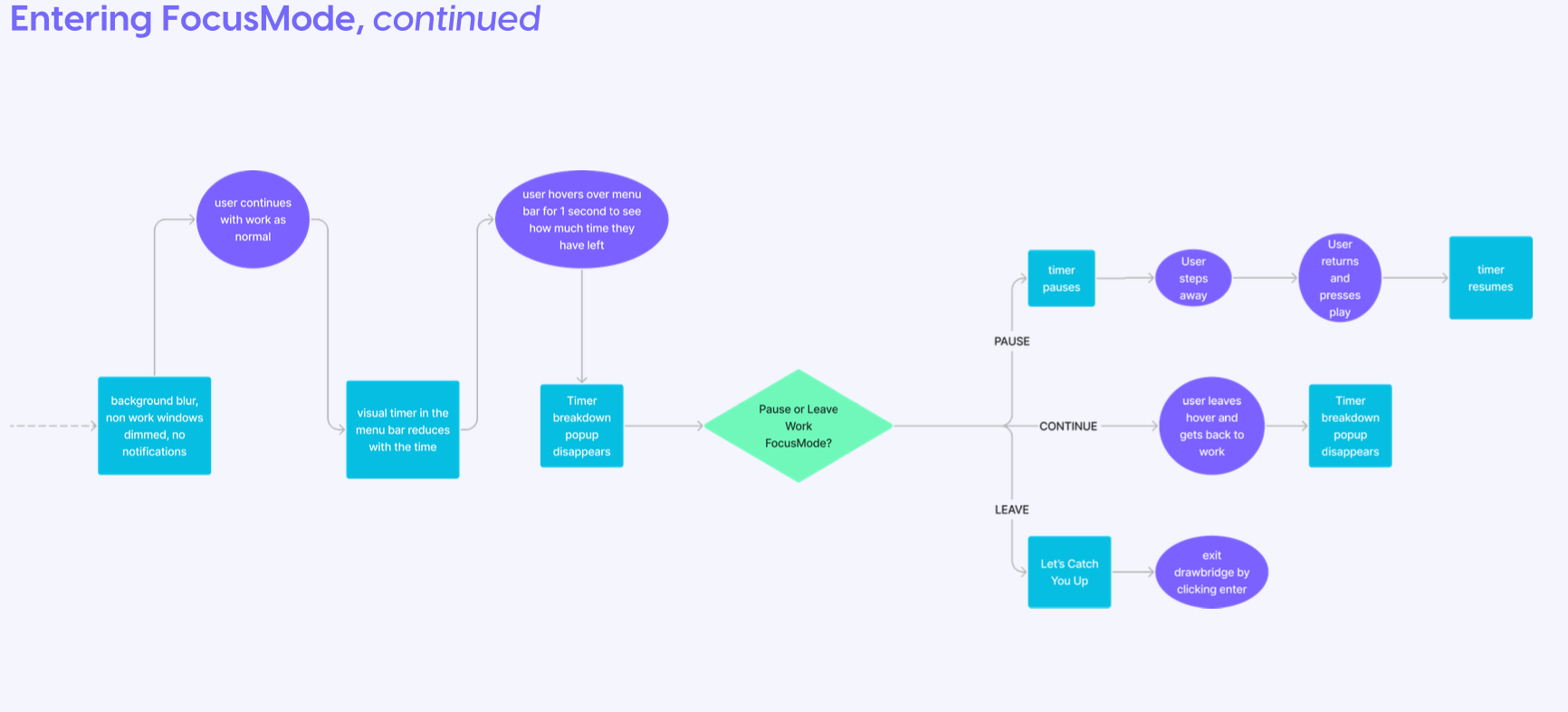
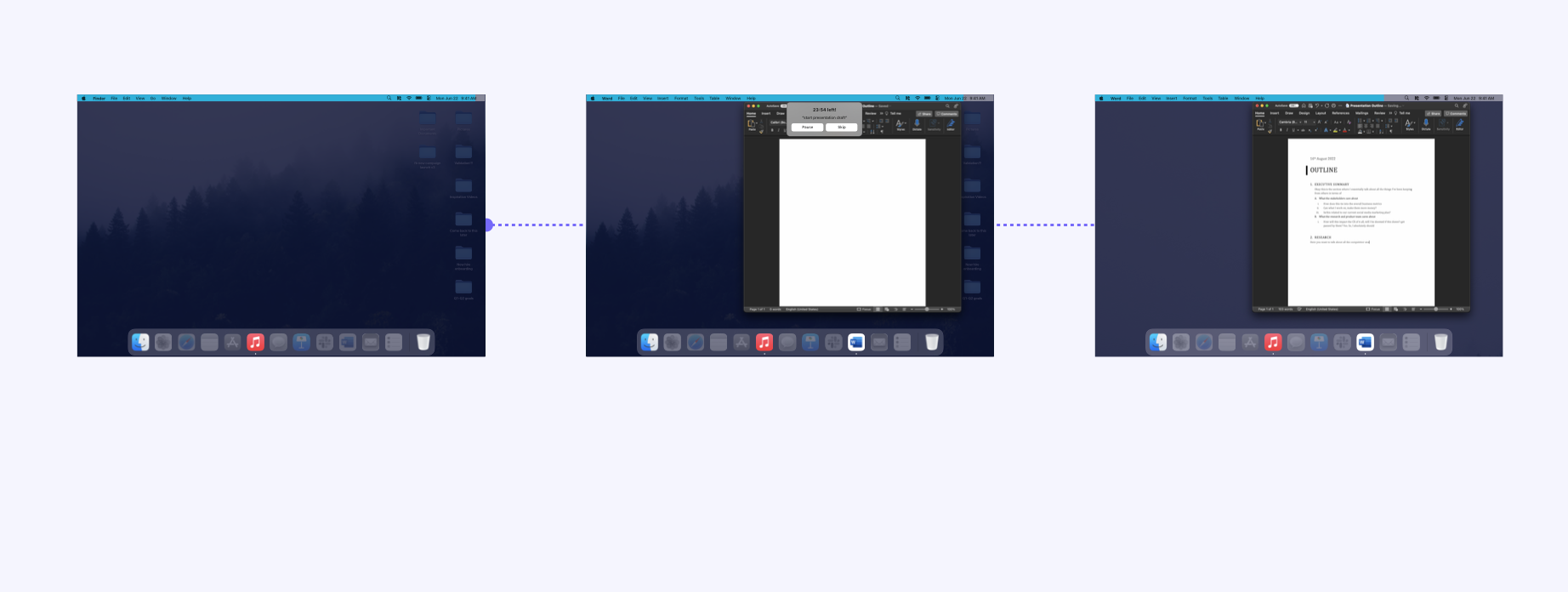

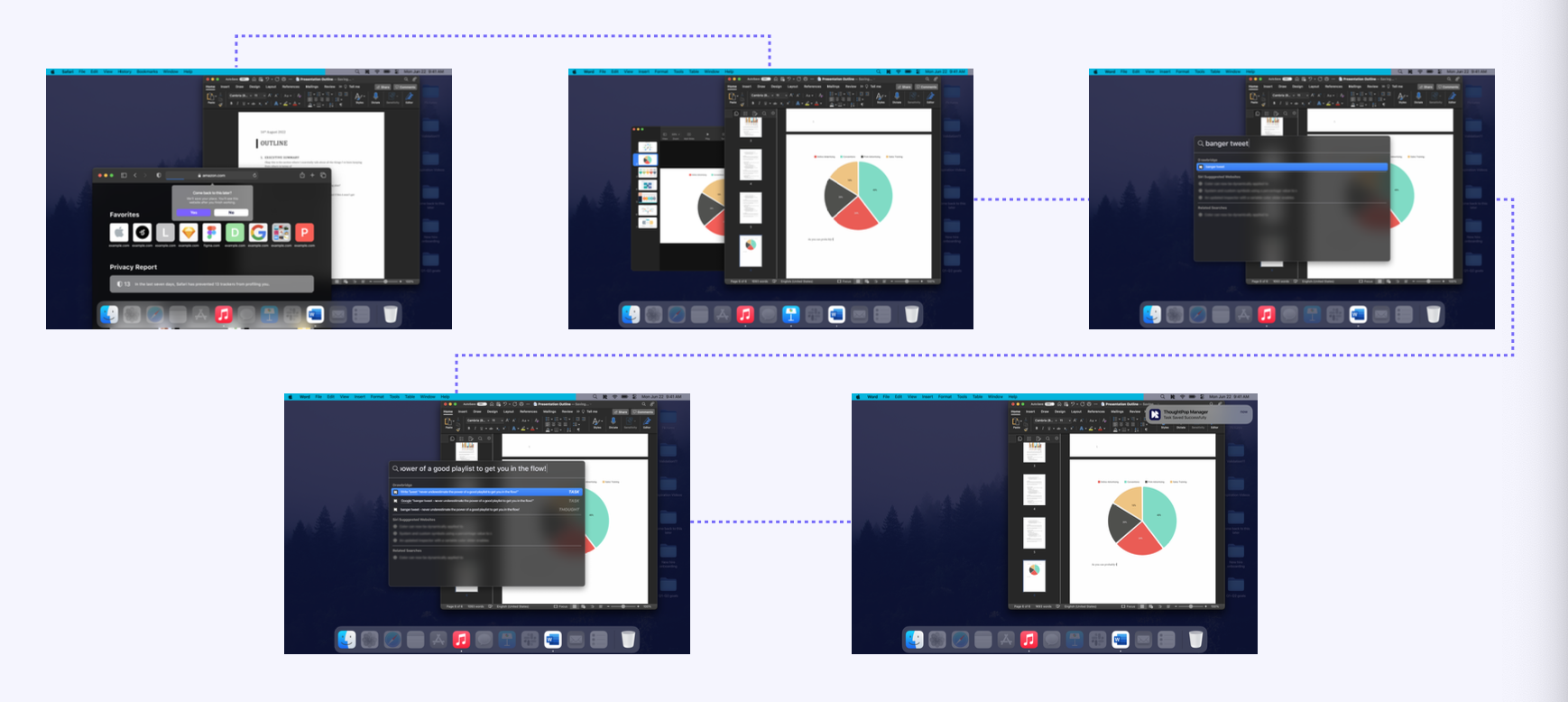
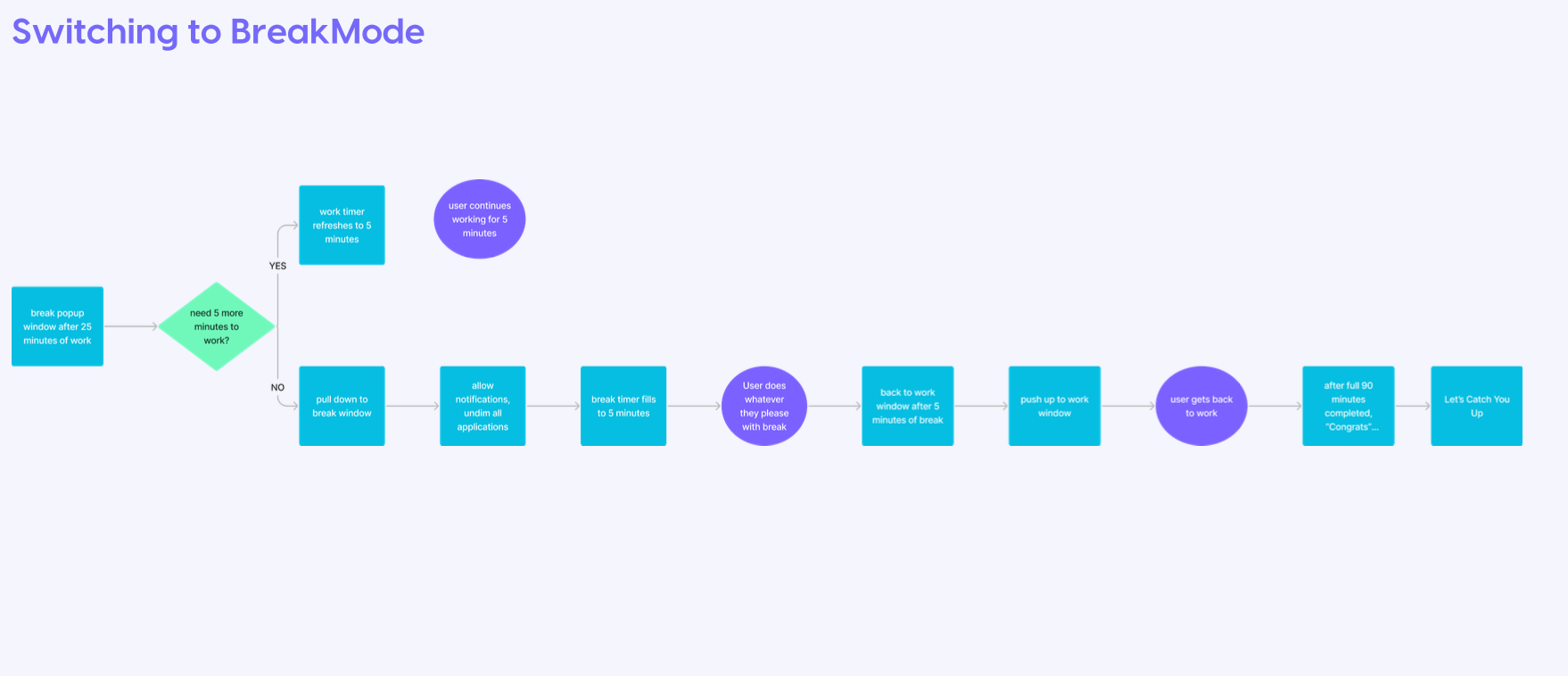

Information Architecture
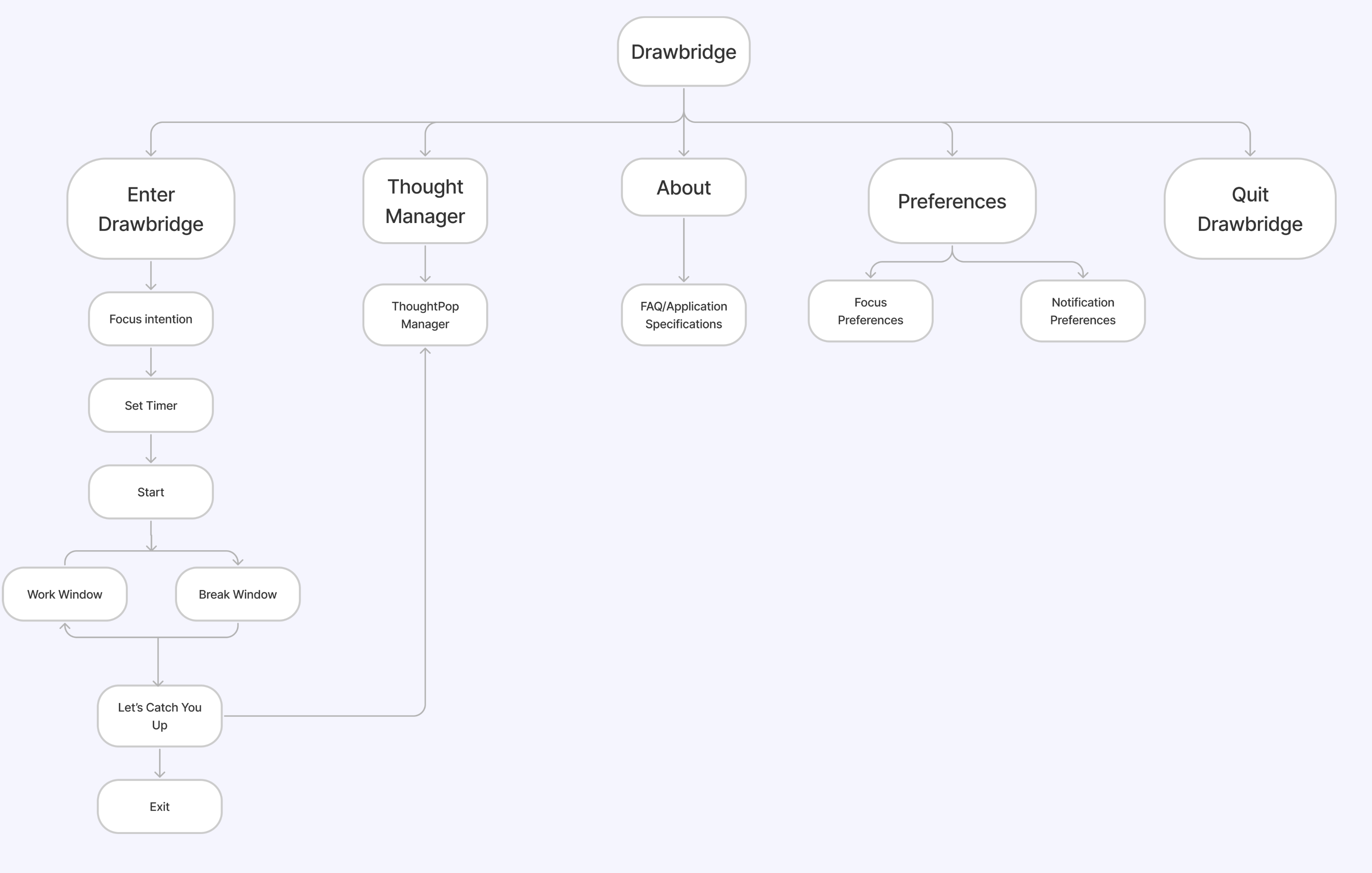
typography
Visual System
Our typeface is the SF Pro family, the official font familly for Apple, Inc. As our product blends into MacOS UI, our typography needs to match the native font.
View 1
H1 SF Pro Display semibold 64px line height: 76
H2 SF Pro Text bold 36px line height: 43
H3 SF Pro Display bold 17px line height: 20
Body SF Pro Display regular 15px line height: 18
View 2
H1 SF Pro Text regular 72px line height: 86
H2 SF Pro Display semibold 32px line height: 38
H3 SF Pro Text regular 16px line height: 19
Body SF Pro Text medium 13px line height: 16
color palette
Our interface uses two main colors, purple and blue-black, with two bright accent colors to infuse the visual system with playfulness.
Drawbridge Purple
#7B61FF
Drawbridge Blue
#ODOF34
White
#F5F5FF
Dark Grey
#6E6F85
Accent Green
#7OF8BA
Accent Blue
#O6BEE1
Primary
Secondary
Accent
Logo
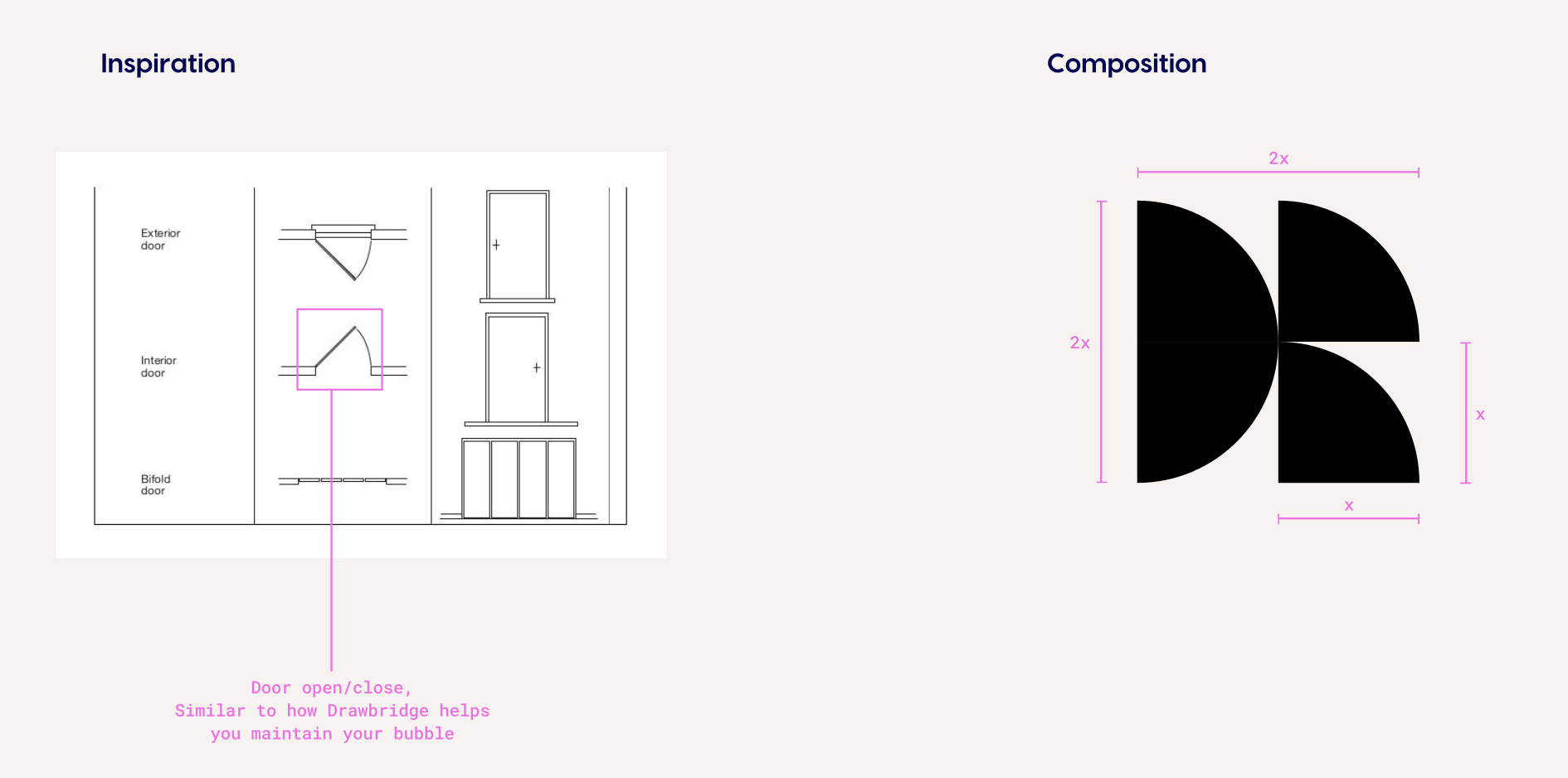
components - buttons
All actionable items have an active and disabled state. Filled buttons indicate a most likely action.
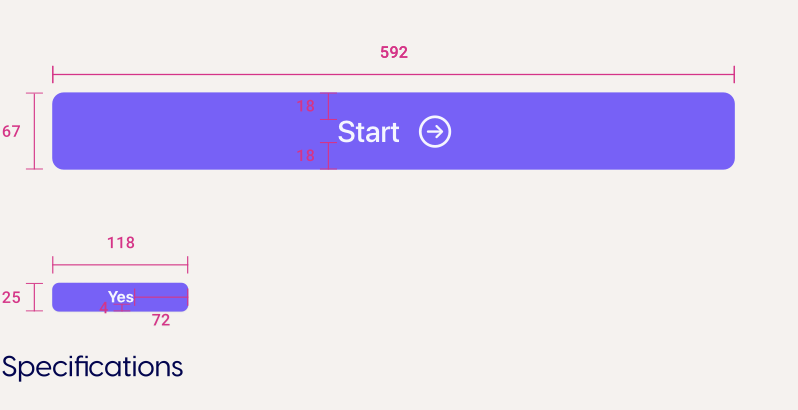
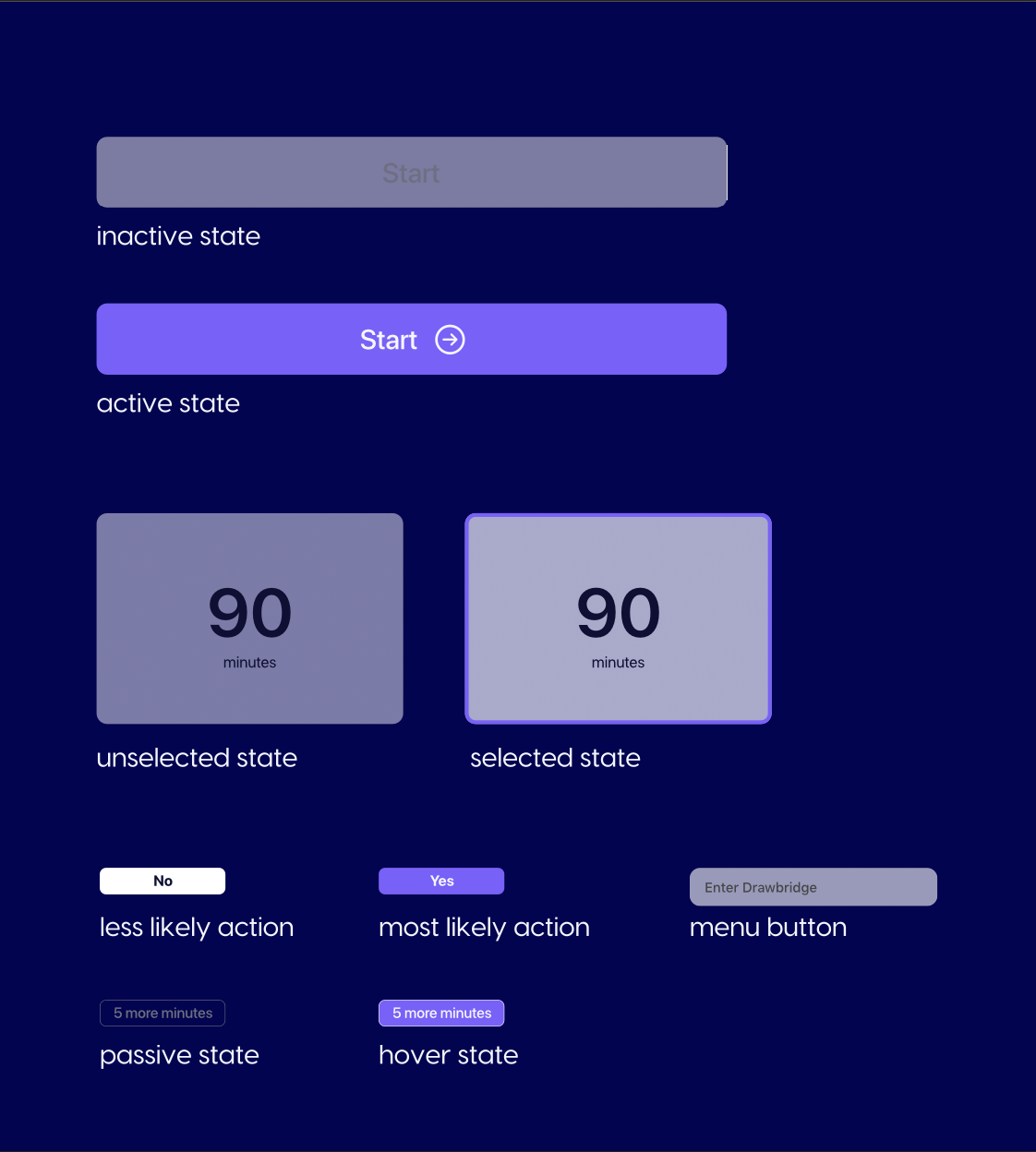
final design specifications
full screen
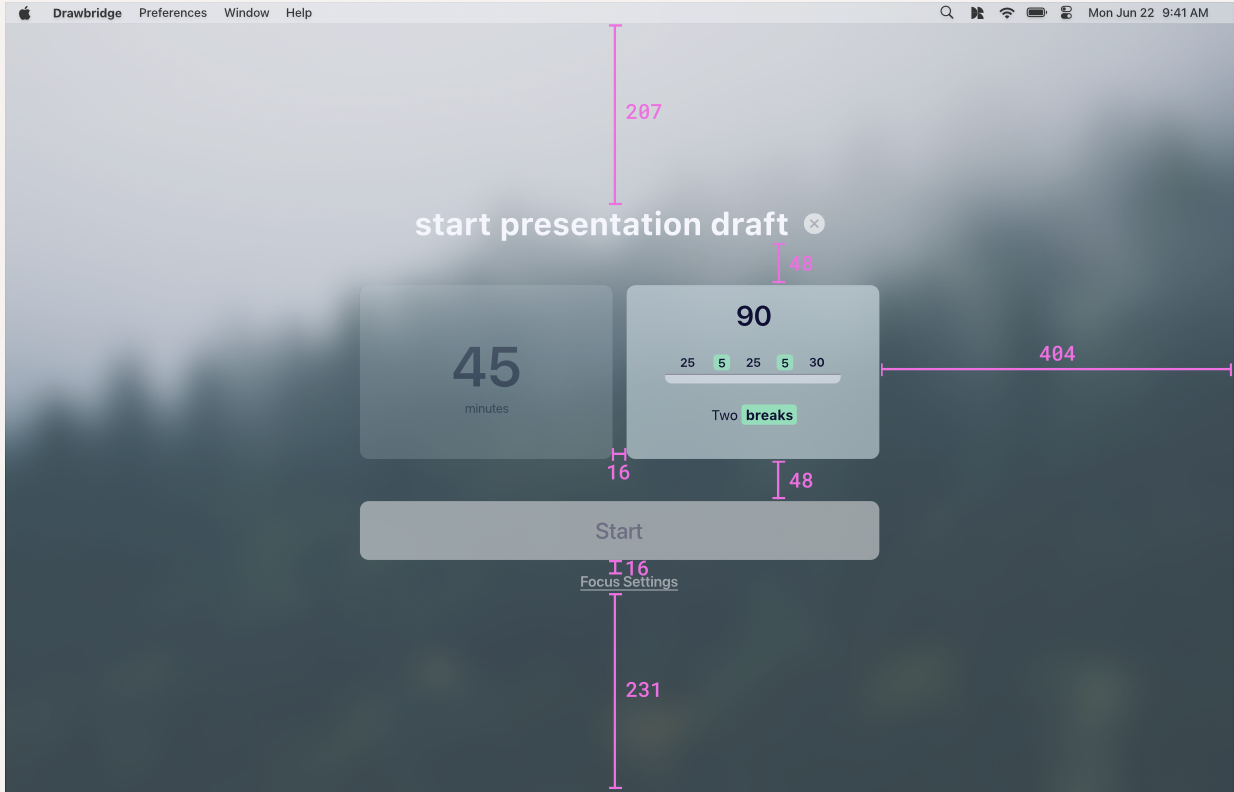
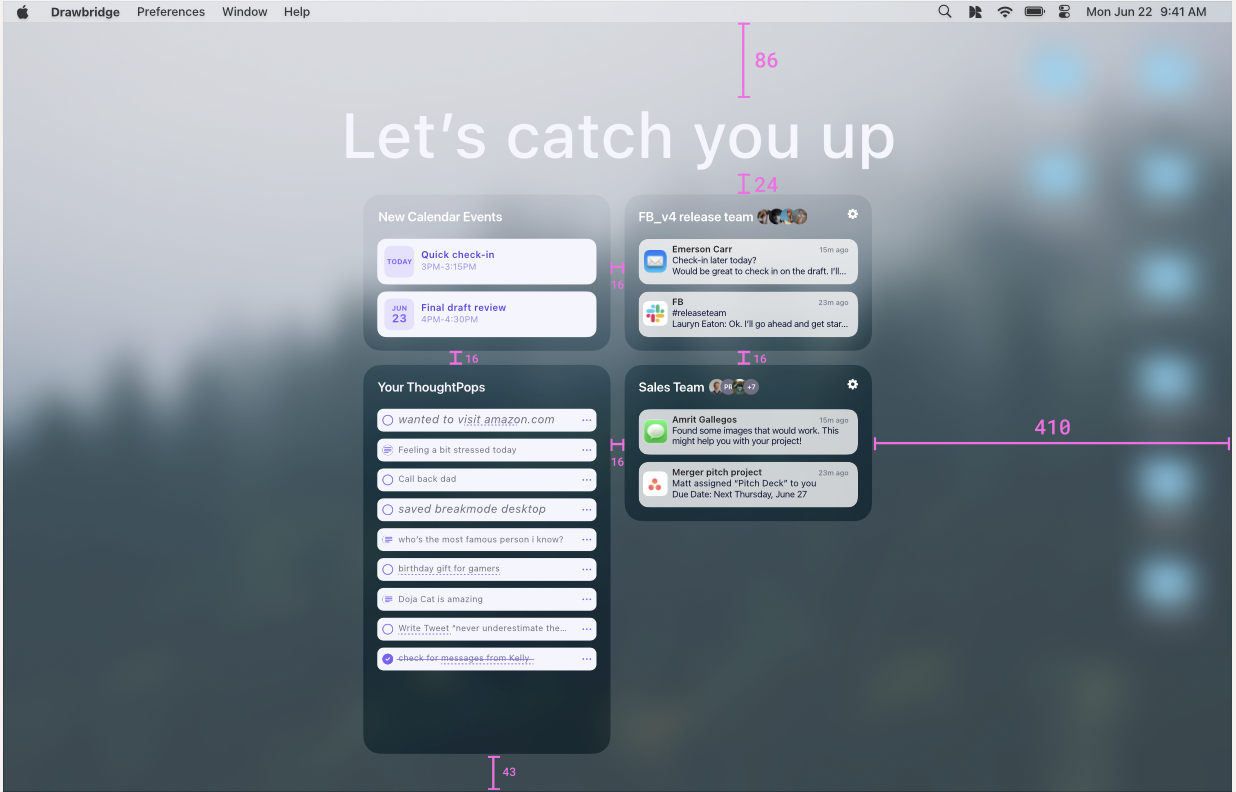
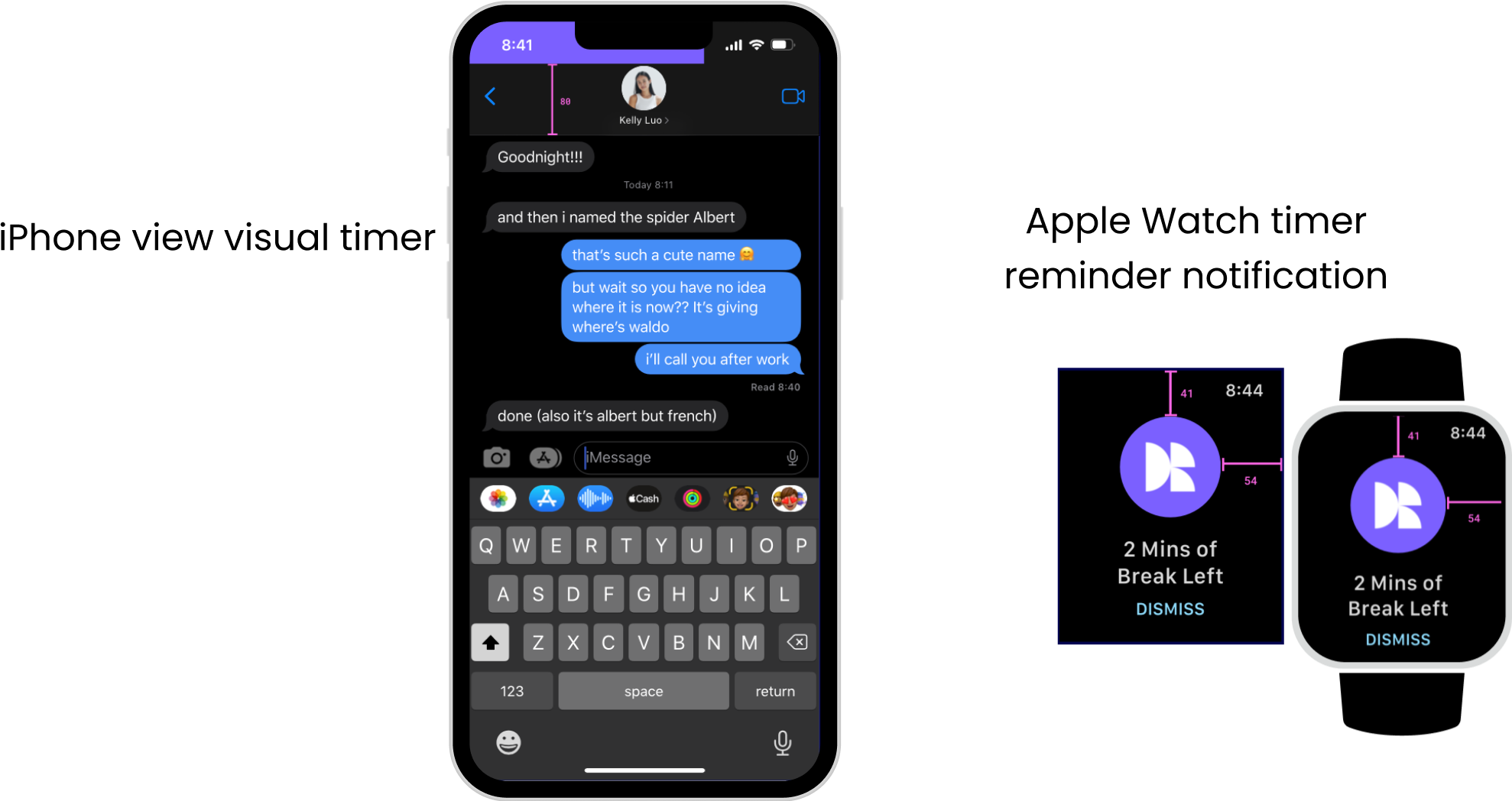
modals
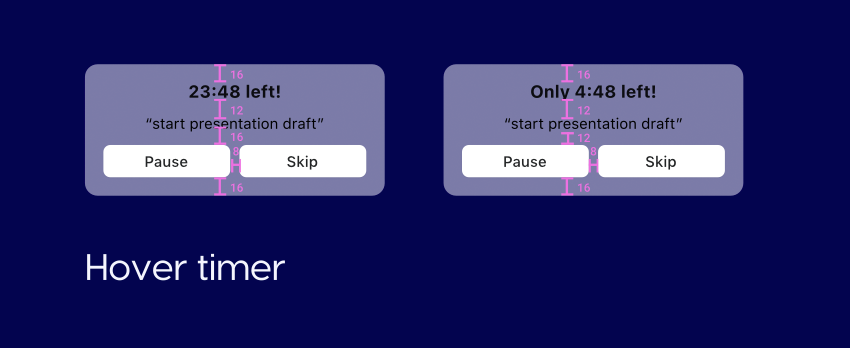
Hover Timer
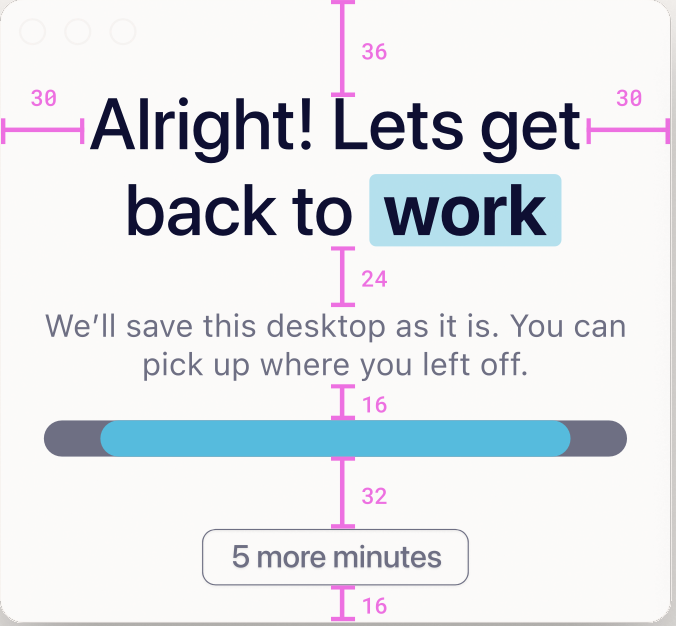
“Back to Work” Modal
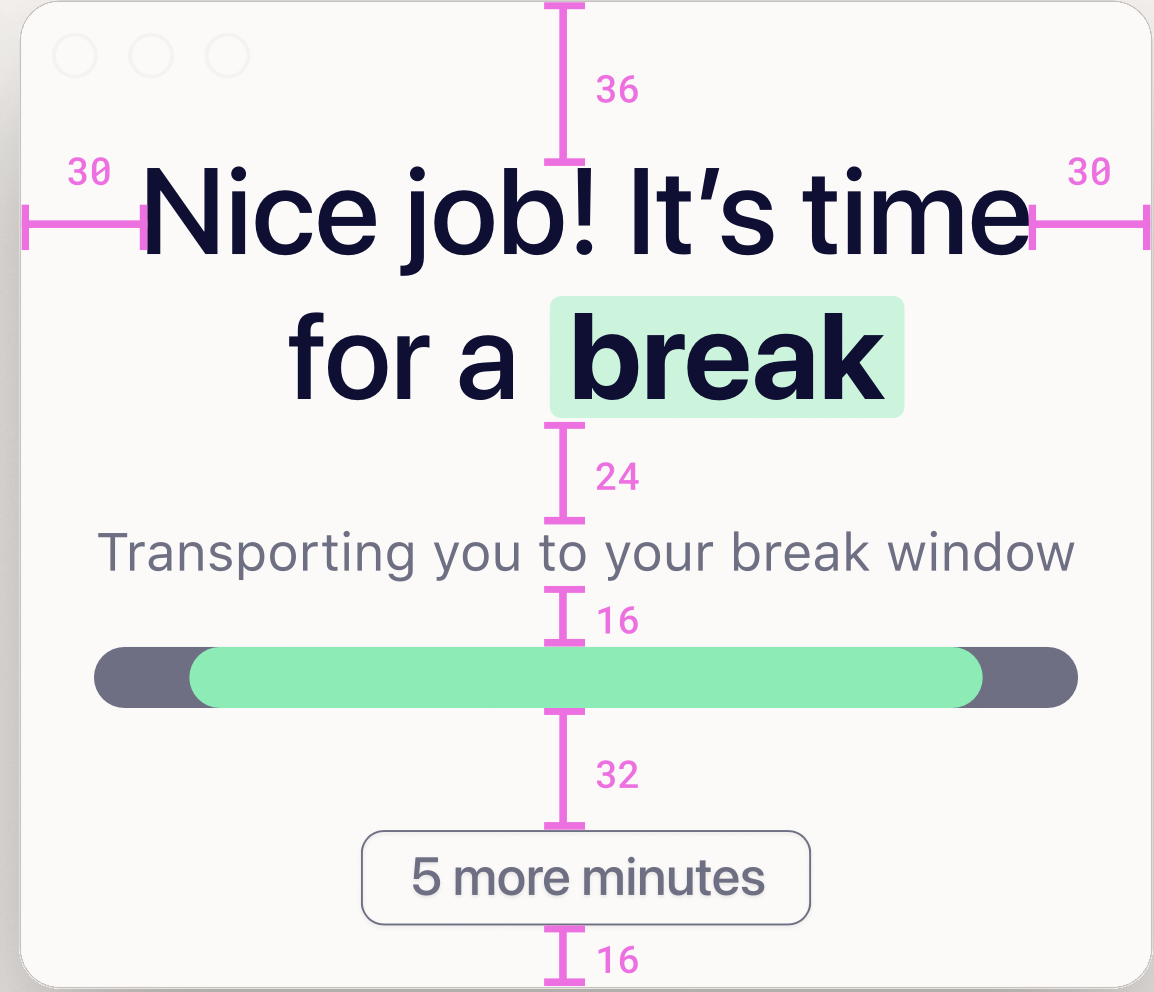
“Take a Break” Modal
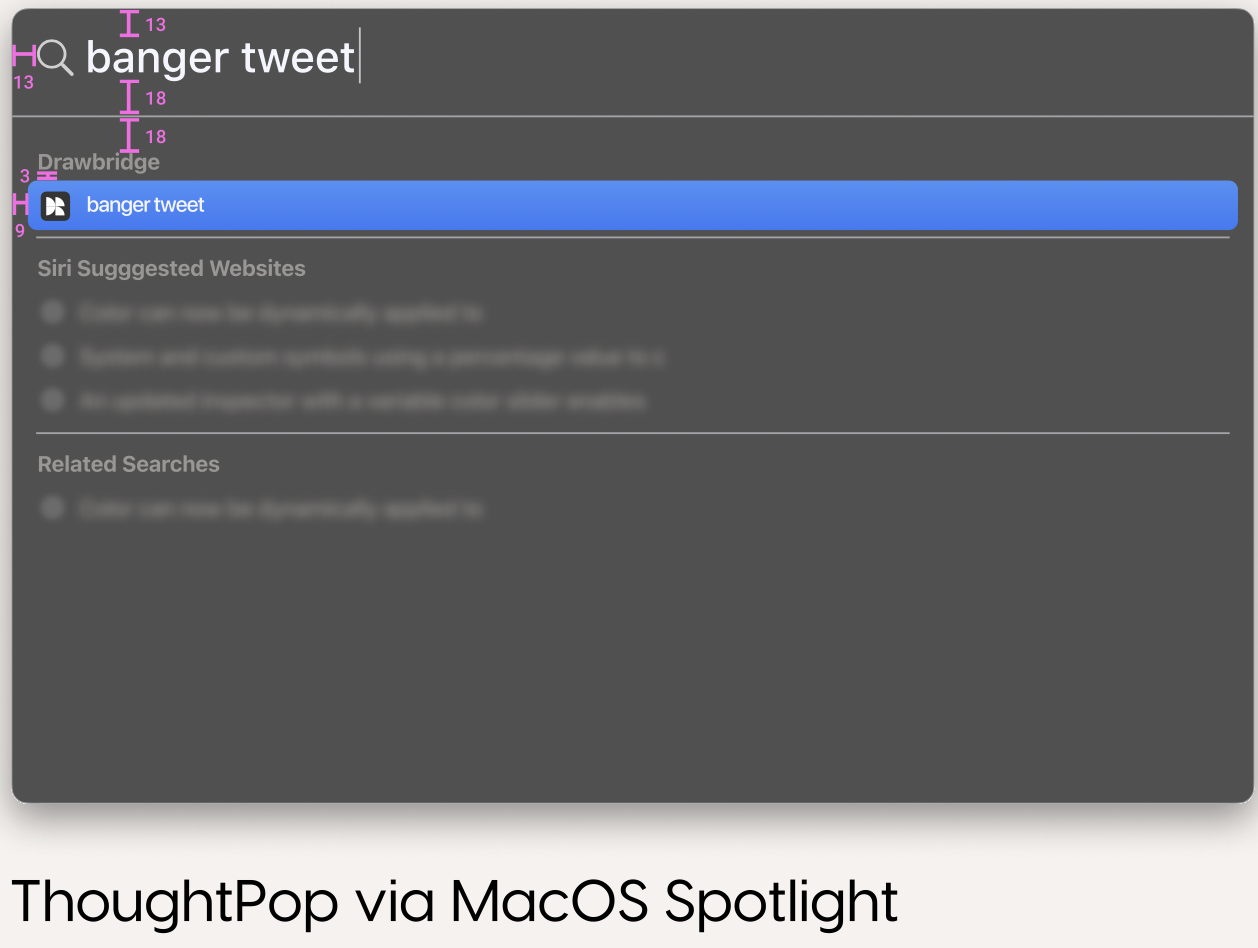
ThougtPop via MacOS Spotlight
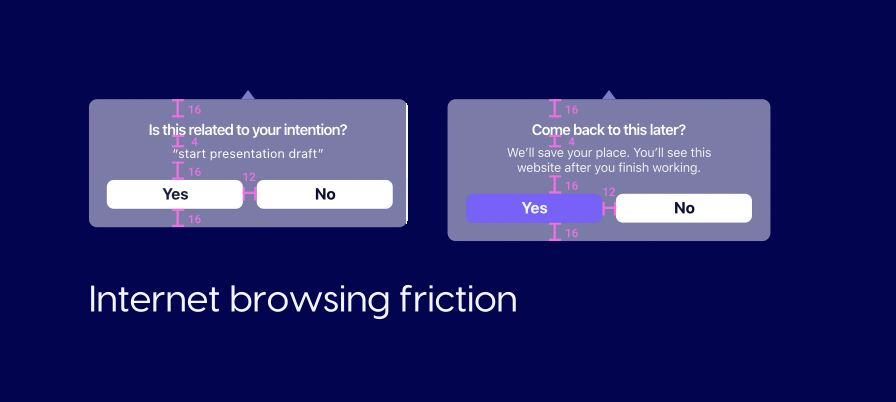
Internet browsing tooltips
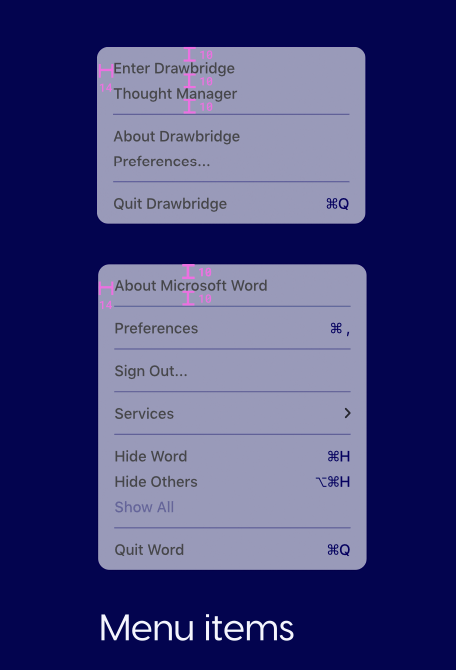
Menu Items
modals in-context

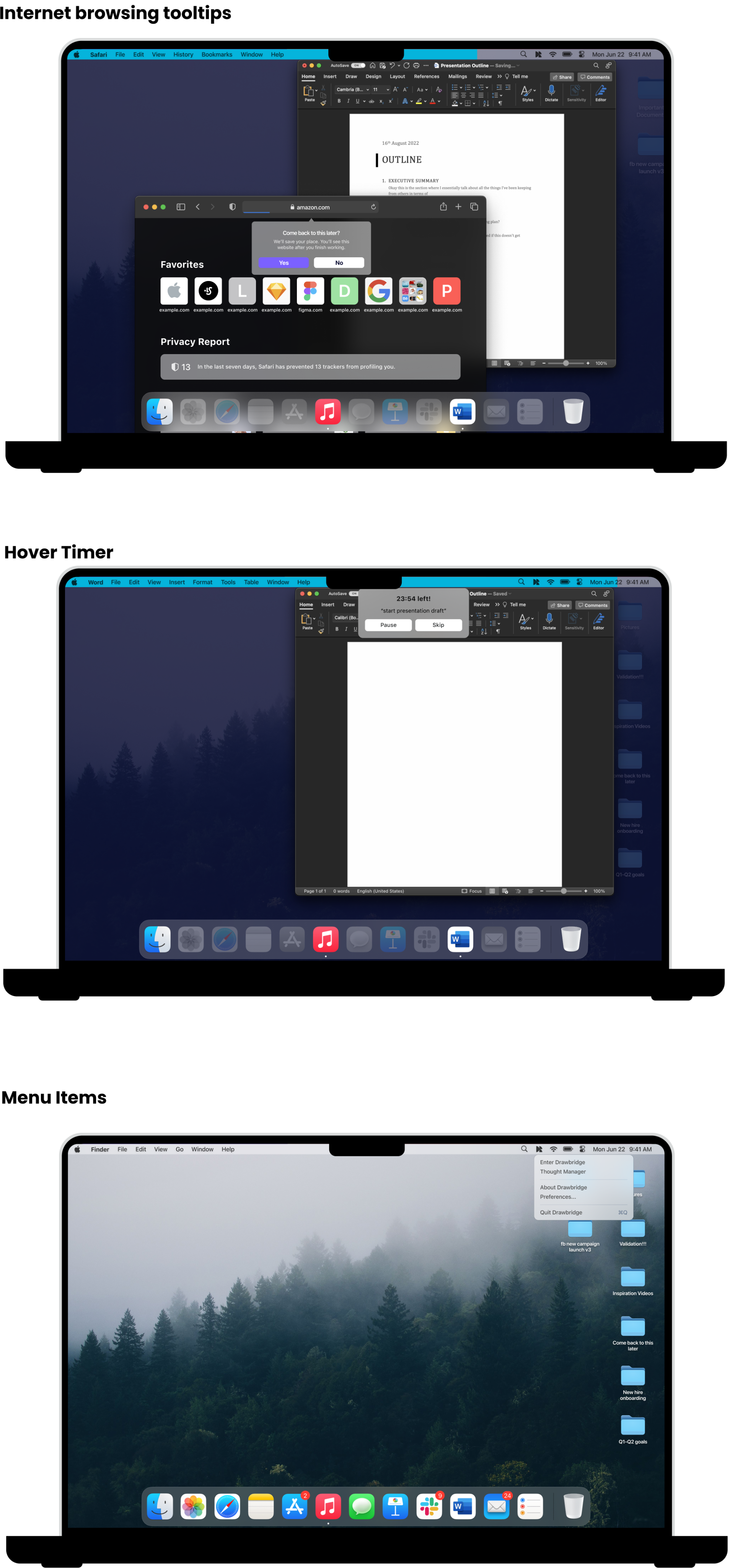
Feedback from our users
“
I would realistically use Drawbridge during my work day!
Participant 6, marketing manager
“
It would be great to add transition time between FocusMode sessions and catching up.
Participant 4, growth officer
“
I could see myself using ThoughtPop a lot, though it would be nice if Drawbridge prioritized my thoughts for me.
Participant 2, consultant

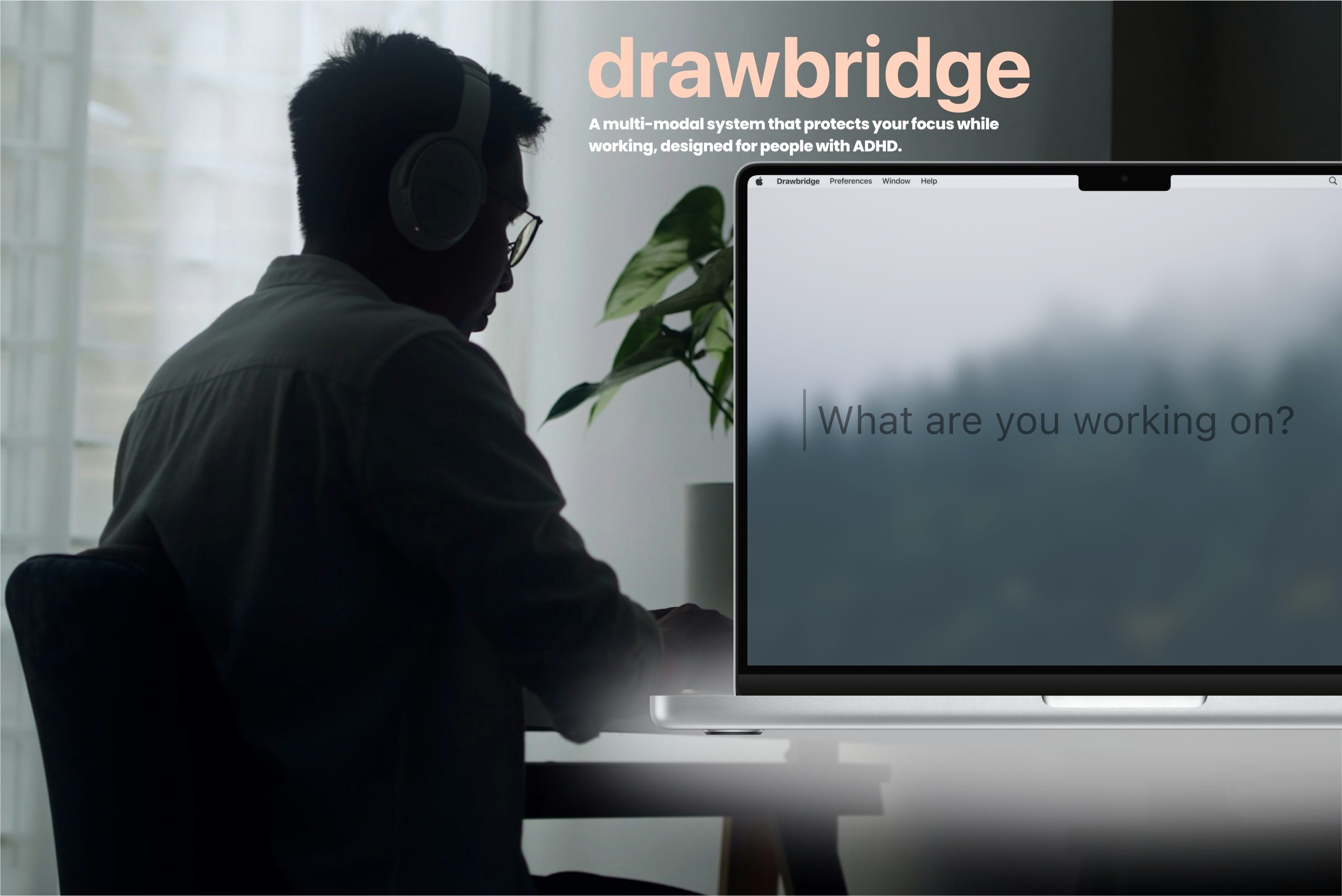
Who:
Design and Research
- Ojurere Shonekan
- Kelly Luo
- Anshuman Dhar
What:
Capstone Project for MHCI+D Master’s Program, University of Washington
When:
6 months: February 2022- August 2022
About
Drawbridge supports your focus by eliminating external distractions and delaying internal distractions.
We designed Drawbridge for people with ADHD, who have an especially fragile process for building focus for work. While we cannot control what distracts us, Drawbridge aims to change how we respond to those distractions.
We wanted to focus on Knowledge Workers that have ADHD, as the self-directed nature of knowledge work conflicts with the strongest presenting symptoms of ADHD..
Background
What is ADHD?
ADHD, or Attention Deficit Hyperactive Disorder:
- difficulty sustaining attention
- disorganization
- forgetfulness
- easy distractibility.
On average, studies suggest that college graduates with attention deficit disorder earn $4,300 less per year than their peers who don’t have ADHD [2].
What is Knowledge Work?
Work that is:
- self-directed
- driven by information
- non-routine and non-linear problem solving
- requires a level of of formal, specialized training
Research
Research Questions

1

2

3

4

5

6
Methodology
N = 9 participants
Participant criteria:
- Diagnosed with ADHD
- Have held a knowledge worker job before
Participant demographics:
- Working professionals diagnosed with ADHD
- Equal gender spread
N = 5 Subject Matter Experts (SME)
SME criteria:
- Have deep experience with ADHD in a medical or professional capacity
Format
- Virtual Zoom interviews
- 1 person moderating, 1 person notetaking
- Recording of the session either via voice recording or Zoom

- We took notes on FigJam sticky notes during each interview.
- After each participant interview we wrote up a one-page summary of the interview highlights, important quotes, and key takeaways.
- After we finished all of our interviews, we coded and analyzed.

Research Plan
Subject Matter Expert Interviews

Key Takeaways
What we learned from talking with SMEs across industries, who were, worked with, and/or studied people that have ADHD(ADDers).
- ADDers have an interest-based nervous system.
- ADDers need to develop their own “owner’s manual” to manage their ADHD.
- There is no one size fits all solution for managing ADHD.
- ADDers need to learn to be “competent and successful in two totally different cultures.” The main culture of workplaces is designed for neurotypical people.
- Externalization of time and tasks can help keep ADDers on track, such as lists, planners, calendars, reminders, and visual timers.
- Minimize task changes. Changing tasks requires cognitive load each time.
- External accountability can help with remembering tasks and emotional regulation.
- ADHD comes with both upsides and downsides. Cannot have one without the other.
- Different ADDers have different playbooks for how to manage their ADHD.
- ADDers often fall into “failure spirals” that result from early friction with systems built for neurotypicals and do not reward their different thinking.
Results

Based on our primary and secondary research, we realized that people with ADHD have a different nervous system than neurotypicals. ADDers don’t rely on an importance-based nervous system, but an interest-based nervous system to navigate the world.
Since interest is subjective, and certain tasks might be extremely uninteresting — they might find themselves in situations where these uninteresting tasks are thus inherently very hard, and sometimes impossible, to perform. In order to overcome these challenges and get the work done, ADDers need to inject interest into tasks.
Having one or more of the three things that drive an interest-based nervous system – such as novelty, urgency, and a challenging, competitive environment – helps them find something interesting and effectively easier to do
Interest-Based Nervous Systems
The Focus Staircase: The process to get work done

Step 1 involves remembering that something needs to be done. It is often hard for ADDers to stay on top of everything that they need to get to do. Failing to remember tasks often leads to unfinished or forgotten work.
1. Remember
Step 2 “Isolate” addresses the conditions ADDers need to get themselves to focus when they feel the need to. There might be agitators and distractions in their environment in terms of the physical like sounds, objects or sensations, as well as in terms of the digital like notifications, meetings etc. ADDers can combat this by having a set of workarounds, almost like a methodology, upon which they rely to get themselves to be able to focus. Each ADDer has a personal repertoire of strategies for focus.
2. Isolate

Step 3 “Focus” is the place where the ADDer feels completely engaged with the work they’re doing at the moment. They’ve gotten themselves to be engaged with their work, are completely focused on it and are getting it done.
They also feel fulfilled and are happy to be able to please their team or coworkers. It takes a lot to get to this point in the process, so if something gets them out of this, it is especially frustrating to them.
3. Focus

FOCUS
ISOLATE
REMEMBER
Starting Point
The Zone
Time
Insights
Finding: While doing solo work, participants find being around people, or background noises extremely distracting.
- ADDers need their own personal isolation bubbles, otherwise it’s impossible to get solo work done.

Finding: Participants have clearly defined times in their day when they are open to talking to people.
- “Not now, Toby!” For ADDers undisturbed solo work time is not a want, it’s a need.

Finding: Participants have specific workarounds which work for them in order to focus.
- Methodology saves the day. Workarounds are the difference between frustration and productivity.

- Getting into focus is like building a house of cards. Once built, it must be protected.
Finding: Since being able to focus sometimes takes so much effort, falling out of it due to external factors feels very distressing.

Finding: They are naturally good in situations which are urgent, rapidly changing, and dynamic.
- ADDers are like firefighters. When the stakes are high, their response matches the speed and urgency of the situation.


Design Principles
Design for ADDers that haven’t disclosed
Most of our participants do not currently disclose and do not plan to share that they have ADHD with their work colleagues. We would like to respect this preference, so our solution aims to be of service to an individual who would like to improve their workflow privately.
Our participant and SME interviews revealed that ADDers learn their own personal work styles, environmental preferences, and time management techniques. We would like to augment the processes ADDers already have in place by designing our solution to be flexible and customizable to whatever degree the user would like.
Be flexible and customizable
Complement their current workflow
We would like our solution to integrate with an ADDer’s existing work techniques, workflow, and tools they currently use. Ideally, our solution will not be an additional cognitive load or task in their everyday work.
Our participants expressed frustration with high levels of interrupting from their workflow by things like emails, notifications, and passerby in their work space. Our solution intends to provide help when it is needed, without contributing to even more sources of distraction.
Be inconspicuous when not needed
Respect their bubble
One of our insights expresses the need for ADDers to have undisturbed work time and a need for isolation during that time. We would like our solution to respect this “bubble” of solo work that each ADDer identifies, builds, and uses to get their work done.
Design
Early Design Process

Downselection was guided by analogy by practical workplace restraints,
What tool could most easily adopted by an individual worker? What tool would do the most for a single person who works by someone else’s calendar? What sort of tool can we design that is customizable for any user? What product could be accessible both in cost and implementation? and our faithfulness to the individual user’s needs.
Our participants’ most pressing issues were distraction from notifications, from other people, and from advocacy for their needs.
We wanted to be careful about what we designed because the “standard” interactions that many desktop apps use now (push notifications, sounds, movement and color) were distracting to our users. We needed to ensure our product did not exacerbate this issue- we stayed true to our design principles and our research.




Set your FocusMode intention Drawbridge encourages you to set an intention before you enter FocusMode. Throughout your work session, Drawbridge reminds you of your goal in moments of distraction, encouraging you to stay on task and meet your target.
Write a ThoughtPopWhen a thought pops into your head while you work, Drawbridge allows you to use the MacOS “Spotlight” feature to quickly type out a thought and save it for later. Drawbridge categorizes your “ThoughtPops” into tasks or just thoughts. By collecting your impulses while you work, Drawbridge keeps and remembers for you while you stay focused.
Let’s Catch You UpWhen you finish your work, Drawbridge delivers all notifications and ThoughtPops in a consolidated screen called “Let’s Catch You Up.” You can also see changes to your calendars and different work groups. This summary view is customizable by application, person, or any combination of the two.
Interaction Flow








Information Architecture

typography
Visual System
Our typeface is the SF Pro family, the official font familly for Apple, Inc. As our product blends into MacOS UI, our typography needs to match the native font.
View 1
H1 SF Pro Display semibold 64px line height: 76
H2 SF Pro Text bold 36px line height: 43
H3 SF Pro Display bold 17px line height: 20
Body SF Pro Display regular 15px line height: 18
View 2
H1 SF Pro Text regular 72px line height: 86
H2 SF Pro Display semibold 32px line height: 38
H3 SF Pro Text regular 16px line height: 19
Body SF Pro Text medium 13px line height: 16
color palette
Our interface uses two main colors, purple and blue-black, with two bright accent colors to infuse the visual system with playfulness.
Drawbridge Purple
#7B61FF
Drawbridge Blue
#ODOF34
White
#F5F5FF
Dark Grey
#6E6F85
Accent Green
#7OF8BA
Accent Blue
#O6BEE1
Primary
Secondary
Accent
Logo

components - buttons
All actionable items have an active and disabled state. Filled buttons indicate a most likely action.


final design specifications
full screen



modals

Hover Timer

“Back to Work” Modal

“Take a Break” Modal

ThougtPop via MacOS Spotlight

Internet browsing tooltips

Menu Items
modals in-context


Feedback from our users
“
I would realistically use Drawbridge during my work day!
Participant 6, marketing manager
“
It would be great to add transition time between FocusMode sessions and catching up.
Participant 4, growth officer
“
I could see myself using ThoughtPop a lot, though it would be nice if Drawbridge prioritized my thoughts for me.
Participant 2, consultant
Overview
Background
Research Plan
SME interviews
research results
insights
design principles
early designs
interaction flow
information architecture
Visual System
final design specs
user feedback

Who:
Design and Research
- Ojurere Shonekan
- Kelly Luo
- Anshuman Dhar
What:
Capstone Project for MHCI+D Master’s Program, University of Washington
When:
6 months: February 2022- August 2022

Who:
Design and Research
- Ojurere Shonekan
- Kelly Luo
- Anshuman Dhar
What:
Capstone Project for MHCI+D Master’s Program, University of Washington
When:
6 months: February 2022- August 2022
Overview
Background
Research Plan
SME interviews
research results
insights
design principles
early designs
interaction flow
information architecture
Visual System
final design specs
user feedback
About
Drawbridge supports your focus by eliminating external distractions and delaying internal distractions.
We designed Drawbridge for people with ADHD, who have an especially fragile process for building focus for work. While we cannot control what distracts us, Drawbridge aims to change how we respond to those distractions.
We wanted to focus on Knowledge Workers that have ADHD, as the self-directed nature of knowledge work conflicts with the strongest presenting symptoms of ADHD..
Background
What is ADHD?
ADHD, or Attention Deficit Hyperactive Disorder:
- difficulty sustaining attention
- disorganization
- forgetfulness
- easy distractibility.
On average, studies suggest that college graduates with attention deficit disorder earn $4,300 less per year than their peers who don’t have ADHD [2].
What is Knowledge Work?
Work that is:
- self-directed
- driven by information
- non-routine and non-linear problem solving
- requires a level of of formal, specialized training
Research
Research Questions

1

2

3

4

5

6
Methodology
N = 9 participants
Participant criteria:
- Diagnosed with ADHD
- Have held a knowledge worker job before
Participant demographics:
- Working professionals diagnosed with ADHD
- Equal gender spread
N = 5 Subject Matter Experts (SME)
SME criteria:
- Have deep experience with ADHD in a medical or professional capacity
Format
- Virtual Zoom interviews
- 1 person moderating, 1 person notetaking
- Recording of the session either via voice recording or Zoom

- We took notes on FigJam sticky notes during each interview.
- After each participant interview we wrote up a one-page summary of the interview highlights, important quotes, and key takeaways.
- After we finished all of our interviews, we coded and analyzed.

Research Plan
Subject Matter Expert Interviews

Key Takeaways
What we learned from talking with SMEs across industries, who were, worked with, and/or studied people that have ADHD(ADDers).
- ADDers have an interest-based nervous system.
- ADDers need to develop their own “owner’s manual” to manage their ADHD.
- There is no one size fits all solution for managing ADHD.
- ADDers need to learn to be “competent and successful in two totally different cultures.” The main culture of workplaces is designed for neurotypical people.
- Externalization of time and tasks can help keep ADDers on track, such as lists, planners, calendars, reminders, and visual timers.
- Minimize task changes. Changing tasks requires cognitive load each time.
- External accountability can help with remembering tasks and emotional regulation.
- ADHD comes with both upsides and downsides. Cannot have one without the other.
- Different ADDers have different playbooks for how to manage their ADHD.
- ADDers often fall into “failure spirals” that result from early friction with systems built for neurotypicals and do not reward their different thinking.
Results

Based on our primary and secondary research, we realized that people with ADHD have a different nervous system than neurotypicals. ADDers don’t rely on an importance-based nervous system, but an interest-based nervous system to navigate the world.
Since interest is subjective, and certain tasks might be extremely uninteresting — they might find themselves in situations where these uninteresting tasks are thus inherently very hard, and sometimes impossible, to perform. In order to overcome these challenges and get the work done, ADDers need to inject interest into tasks.
Having one or more of the three things that drive an interest-based nervous system – such as novelty, urgency, and a challenging, competitive environment – helps them find something interesting and effectively easier to do
Interest-Based Nervous Systems
The Focus Staircase: The process to get work done

Step 1 involves remembering that something needs to be done. It is often hard for ADDers to stay on top of everything that they need to get to do. Failing to remember tasks often leads to unfinished or forgotten work.
1. Remember
Step 2 “Isolate” addresses the conditions ADDers need to get themselves to focus when they feel the need to. There might be agitators and distractions in their environment in terms of the physical like sounds, objects or sensations, as well as in terms of the digital like notifications, meetings etc. ADDers can combat this by having a set of workarounds, almost like a methodology, upon which they rely to get themselves to be able to focus. Each ADDer has a personal repertoire of strategies for focus.
2. Isolate

Step 3 “Focus” is the place where the ADDer feels completely engaged with the work they’re doing at the moment. They’ve gotten themselves to be engaged with their work, are completely focused on it and are getting it done.
They also feel fulfilled and are happy to be able to please their team or coworkers. It takes a lot to get to this point in the process, so if something gets them out of this, it is especially frustrating to them.
3. Focus

FOCUS
ISOLATE
REMEMBER
Starting Point
The Zone
Time
Insights
Finding: While doing solo work, participants find being around people, or background noises extremely distracting.
- ADDers need their own personal isolation bubbles, otherwise it’s impossible to get solo work done.

Finding: Participants have clearly defined times in their day when they are open to talking to people.
- “Not now, Toby!” For ADDers undisturbed solo work time is not a want, it’s a need.

Finding: Participants have specific workarounds which work for them in order to focus.
- Methodology saves the day. Workarounds are the difference between frustration and productivity.

- Getting into focus is like building a house of cards. Once built, it must be protected.
Finding: Since being able to focus sometimes takes so much effort, falling out of it due to external factors feels very distressing.

Finding: They are naturally good in situations which are urgent, rapidly changing, and dynamic.
- ADDers are like firefighters. When the stakes are high, their response matches the speed and urgency of the situation.


Design Principles
Design for ADDers that haven’t disclosed
Most of our participants do not currently disclose and do not plan to share that they have ADHD with their work colleagues. We would like to respect this preference, so our solution aims to be of service to an individual who would like to improve their workflow privately.
Our participant and SME interviews revealed that ADDers learn their own personal work styles, environmental preferences, and time management techniques. We would like to augment the processes ADDers already have in place by designing our solution to be flexible and customizable to whatever degree the user would like.
Be flexible and customizable
Complement their current workflow
We would like our solution to integrate with an ADDer’s existing work techniques, workflow, and tools they currently use. Ideally, our solution will not be an additional cognitive load or task in their everyday work.
Our participants expressed frustration with high levels of interrupting from their workflow by things like emails, notifications, and passerby in their work space. Our solution intends to provide help when it is needed, without contributing to even more sources of distraction.
Be inconspicuous when not needed
Respect their bubble
One of our insights expresses the need for ADDers to have undisturbed work time and a need for isolation during that time. We would like our solution to respect this “bubble” of solo work that each ADDer identifies, builds, and uses to get their work done.
Design
Early Design Process

Downselection was guided by analogy by practical workplace restraints,
What tool could most easily adopted by an individual worker? What tool would do the most for a single person who works by someone else’s calendar? What sort of tool can we design that is customizable for any user? What product could be accessible both in cost and implementation? and our faithfulness to the individual user’s needs.
Our participants’ most pressing issues were distraction from notifications, from other people, and from advocacy for their needs.
We wanted to be careful about what we designed because the “standard” interactions that many desktop apps use now (push notifications, sounds, movement and color) were distracting to our users. We needed to ensure our product did not exacerbate this issue- we stayed true to our design principles and our research.




Set your FocusMode intention Drawbridge encourages you to set an intention before you enter FocusMode. Throughout your work session, Drawbridge reminds you of your goal in moments of distraction, encouraging you to stay on task and meet your target.
Write a ThoughtPopWhen a thought pops into your head while you work, Drawbridge allows you to use the MacOS “Spotlight” feature to quickly type out a thought and save it for later. Drawbridge categorizes your “ThoughtPops” into tasks or just thoughts. By collecting your impulses while you work, Drawbridge keeps and remembers for you while you stay focused.
Let’s Catch You UpWhen you finish your work, Drawbridge delivers all notifications and ThoughtPops in a consolidated screen called “Let’s Catch You Up.” You can also see changes to your calendars and different work groups. This summary view is customizable by application, person, or any combination of the two.
Interaction Flow








Information Architecture

typography
Visual System
Our typeface is the SF Pro family, the official font familly for Apple, Inc. As our product blends into MacOS UI, our typography needs to match the native font.
View 1
H1 SF Pro Display semibold 64px line height: 76
H2 SF Pro Text bold 36px line height: 43
H3 SF Pro Display bold 17px line height: 20
Body SF Pro Display regular 15px line height: 18
View 2
H1 SF Pro Text regular 72px line height: 86
H2 SF Pro Display semibold 32px line height: 38
H3 SF Pro Text regular 16px line height: 19
Body SF Pro Text medium 13px line height: 16
color palette
Our interface uses two main colors, purple and blue-black, with two bright accent colors to infuse the visual system with playfulness.
Drawbridge Purple
#7B61FF
Drawbridge Blue
#ODOF34
White
#F5F5FF
Dark Grey
#6E6F85
Accent Green
#7OF8BA
Accent Blue
#O6BEE1
Primary
Secondary
Accent
Logo

components - buttons
All actionable items have an active and disabled state. Filled buttons indicate a most likely action.


final design specifications
full screen


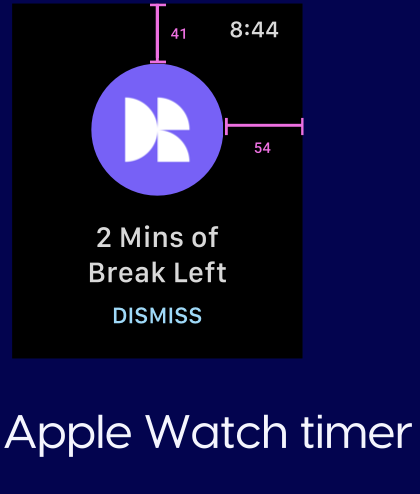
iPhone view visual timer
Apple Watch timer reminder notification
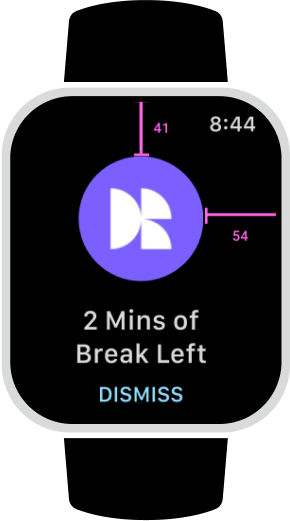
modals

Hover Timer

“Back to Work” Modal

“Take a Break” Modal

ThougtPop via MacOS Spotlight

Internet browsing tooltips

Menu Items
modals in-context


Feedback from our users
“
I would realistically use Drawbridge during my work day!
Participant 6, marketing manager
“
It would be great to add transition time between FocusMode sessions and catching up.
Participant 4, growth officer
“
I could see myself using ThoughtPop a lot, though it would be nice if Drawbridge prioritized my thoughts for me.
Participant 2, consultant
